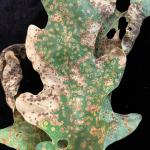UMass Extension's Landscape Message is an educational newsletter intended to inform and guide Massachusetts Green Industry professionals in the management of our collective landscape. Detailed reports from scouts and Extension specialists on growing conditions, pest activity, and cultural practices for the management of woody ornamentals, trees, and turf are regular features. The following issue has been updated to provide timely management information and the latest regional news and environmental data.
The Landscape Message will be updated bi-monthly in July. The next message will be posted on July 23. To receive immediate notification when the next Landscape Message update is posted, be sure to join our e-mail list
To read individual sections of the message, click on the section headings below to expand the content:
Scouting Information by Region
Environmental Data
The following data was collected on or about July 7, 2021. Total accumulated growing degree days (GDD) represent the heating units above a 50° F baseline temperature collected via regional NEWA stations for the 2021 calendar year. This information is intended for use as a guide for monitoring the developmental stages of pests in your location and planning management strategies accordingly.
|
MA Region/Location |
GDD |
Soil Temp |
Precipitation |
Time/Date of Readings |
||
|
2-Week Gain |
2021 Total |
Sun |
Shade |
|||
|
CAPE |
305 |
978 |
71 |
66 |
1.37 |
12:00 PM 7/7 |
|
SOUTHEAST |
309 |
1041.5 |
74 |
87 |
3.75 |
3:00 PM 7/7 |
|
NORTH SHORE |
309 |
1147 |
70 |
65 |
2.90 |
10:00 AM 7/7 |
|
EAST |
309.5 |
1156 |
82 |
74 |
6.37 |
5:00 PM 7/7 |
|
METRO |
292 |
1077.5 |
67 |
65 |
3.62 |
5:30 AM 7/7 |
|
CENTRAL |
297 |
1109.5 |
68 |
67 |
5.31 |
7:00 AM 7/7 |
|
PIONEER VALLEY |
304 |
1116.5 |
73 |
67 |
2.82 |
1:00 PM 7/7 |
|
BERKSHIRES |
268 |
892.5 |
70 |
67 |
6.62 |
7:30 AM 7/7 |
|
AVERAGE |
299 |
1065 |
72 |
70 |
4.10 |
_ |
|
n/a = information not available |
||||||
As of 7/6, there is a "moderate drought" status for the outer Cape and "abnormally dry" conditions for the other half of the Cape and the Islands: https://droughtmonitor.unl.edu/CurrentMap/StateDroughtMonitor.aspx?MA
Current municipal water restrictions are shown on this map: https://www.mass.gov/doc/water-use-restrictions-map/download
Phenology
| Indicator Plants - Stages of Flowering (BEGIN, BEGIN/FULL, FULL, FULL/END, END) | |||||||||
|---|---|---|---|---|---|---|---|---|---|
| PLANT NAME (Botanic / Common) | CAPE | S.E. | N.S. | EAST | METRO W. | CENT. | P.V. | BERK. | |
|
Koelreuteria paniculata (goldenrain tree) |
Begin |
* |
Begin |
Begin |
Begin |
Begin |
Begin |
* |
|
|
Buddleia davidii (butterfly bush) |
Begin |
Full |
Begin/Full |
Begin |
Begin/Full |
* |
Begin |
* |
|
|
Campsis radicans (trumpet vine) |
Begin |
Full |
Full |
Begin/Full |
Full |
* |
Full |
Begin |
|
|
Lythrum salicaria (purple loosestrife) |
Begin |
Full |
Full |
Begin |
* |
Full |
Full |
* |
|
|
Hydrangea macrophylla (bigleaf hydrangea) |
Begin/Full |
Full |
Full |
Full |
Full |
Full |
Full |
Begin/Full |
|
|
Rhus typhina (staghorn sumac) |
Full |
Full |
Full |
Full |
Full |
Full |
Full |
Begin/Full |
|
|
Hydrangea arborescens (smooth hydrangea) |
Full |
* |
Full |
Full |
Full |
Full |
Full |
Full |
|
|
Sambucus canadensis (American elderberry) |
Begin/Full |
Full/End |
Full/End |
End |
Full/End |
Full |
Full/End |
Full/End |
|
|
Itea virginica (Virginia sweetspire) |
Full/End |
* |
End |
End |
End |
End |
End |
Full/End |
|
|
Euonymus alatus (winged euonymus, burning bush) |
End |
* |
End |
End |
End |
End |
End |
End |
|
| * = no activity to report/information not available | |||||||||
Regional Notes
Cape Cod Region (Barnstable)
General Conditions: The average temperature for the period from June 23 thru July 7 was 71˚F with a high of 91˚F on June 29 and a low of 52˚F on June 24. The period began with a cool day and temperatures steadily increased with highs in the upper 80s from June 28 – July 1. This was followed by (disappointing holiday weather) a cool, cloudy, misty period from July 2 – July 5, with July 3 and 4 struggling to reach the mid-60s. Other than the July 2-5 stretch, the days were sunny or mostly sunny. Precipitation totaled 1.37 inches during the period, the majority coming on July 3, but precipitation did fall on 5 days during the period. The July 1- July 5 combo of mist and near 100% relative humidity is likely to have been ideal for some fungal foliar pathogens. Woody plants seen in bloom during the period include catalpa, stewartia, kousa dogwood, Japanese spiraea, New Jersey tea, privet, false spirea, oakleaf hydrangea, and roses. Herbaceous plants in bloom include daylily, Asiatic lily, astilbe, liatris, echinacea, shasta daisy, oxeye daisy, coreopsis, kniphofia, lavender, hosta, catmint, crocosmia, perovskia, St John’s wort, creeping bellflower, achillea, lamb’s ear, yucca, butterfly weed, Baptisia tinctoria, and cutleaf coneflower.
Pests/Problems: Insect pests or damage seen during the period includes Japanese, Oriental, and Asiatic beetles, daylily leafminer on daylily, euonymus scale on winged euonymus, white prunicola scale on lilac, lilac borer damage on privet, black turpentine beetle on pitch pine, hemlock wooly adelgid and hemlock elongate scale on hemlock, hibiscus sawfly on hardy hibiscus, witchhazel cone gall on witchhazel, azalea lacebug on azalea, andromeda lacebug on andromeda, and earwig damage to various plants. Plant disease symptoms or signs observed during the period include maple anthracnose, blackspot on rose, and leaf spot on river birch. Weeds and wildflowers seen in bloom were sheep’s bit (Jasione montana), spotted knapweed, rabbitfoot clover, white clover, birdsfoot trefoil, yellow toadflax, Queen Annes’ lace, and narrowleaf plantain. Bunnies and wood chucks abound. Protect yourself from mosquitoes and ticks; also beware of wasps and hornets.
Southeast Region (Dighton)
General Conditions: The weather has been erratic and variable. We've had steaming tropical humidity and heat in the nineties, broken by violent thunderstorms and downpours, then sweater weather in the fifties. Among the many plants in flower I've noticed: Achillea (yarrow), Alcea spp. (hollyhock), Asclepias incarnata (swamp milkweed), A. syriaca (common milkweed), Aesculus parviflora (bottlebrush buckeye), Astilbe biternata (false goat's beard), Buddleia davidii (butterfly bush), Calystegia sepium (hedge bindweed), Campanula rapunculoides (creeping bellflower), Campsis radicans (trumpet vine), Castanea mollissima (Chinese chestnut), Centaurea cyanus (cornflower), C. stoebe (spotted knapweed), Cephalanthus occidentalis (button bush), Clematis, Coreopsis (tickseed), Cornus.racemosa (grey dogwood), Daucus carota (Queen Anne's lace), Dasiphora fruticosa (shrubby cinquefoil), Echinacea purpurea (purple coneflower), Hemerocallis fulva (orange daylily), Hosta var. (plantain lilies), Hydrangea macrophylla (bigleaf hydrangea), H. paniculata (panicled hydrangea), Hypericum perforatum (St. John's-wort), Lathyrus latifolius (perennial peavine), Leucanthemum x superbum (shasta daisy), Liatris (blazing star), Ligustrum spp.(privet), Lilium spp.(true lilies), Linaria vulgaris (yellow toadflax), Lotus corniculatus (birdsfoot trefoil), Lonicera japonica (Japanese honeysuckle), Lonicera x heckrottii 'Goldflame' (gold flame honeysuckle), Lysimachia ciliata (fringed loosestrife), L. clethroides (gooseneck loosestrife), Lythrum salicaria (purple loosestrife), Monarda didyma (scarlet beebalm), Nepta spp. (catnip), Nuphar lutea (yellow water lily), Opuntia humifusa (prickly pear), Oxydendrum arboreum (sourwood, sorrel tree), Phlox paniculata (garden phlox), Pilosella caespitosa (yellow hawkweed), Platycodon grandiflorus (balloon flower), Rhododendron viscosum (swamp white azalea), Rhus typhina (staghorn sumac), Rosa spp. (rose), Rudbeckia hirta (black-eyed-Susan), Salvia yangii (Russian sage), Sambucus canadensis (elderberry), Silene coronaria (rose campion), S. latifolia (white campion), Spiraea alba (white meadowsweet), Stewartia pseudocamellia (Korean stewartia), Tanacetum vulgare (tansy), Thalictrum dioicum (early meadow rue), Trifolium repens (white clover), Typha latifolia (cattail), Viola tricolor (wild pansy), Verbascum thapsus (greater mullein), Vernonia noveboracensis (ironweed), and Yucca flaccida (Adam's needle).
Pests/Problems: Popillia japonica (Japanese beetle) adults are out in number. I haven't noticed Japanese Beetles locally in quite a number of seasons which makes me wonder if we may have an outbreak in the coming years. Cyclocephala borealis (northern masked chafer) adults on rose. Tremex columba (pigeon tremex) on Norway maple. If you aren't familiar with them, horntails are wasps whose larvae are tree borers. Pigeon tremex tend to use trees that are otherwise already in a state of decline, and are typically not primary pests of trees.
North Shore (Beverly)
General Conditions: The weather during the past two weeks was quite variable, ranging from dry, hot and humid to cool and rainy days. Day temperatures ranged from the low 70s to mid-90s and night temperatures ranged from low 50s to mid-70s. The average daily temperature was 72℉ with a minimum temperature of 50°F recorded on June 24 and a maximum temperature of 95℉ recorded on June 28 and 29. A cold front came through in the middle of this reporting period and brought beneficial rains. Most of the rain (1.53 inches) fell on July 2. Approximately 2.90 inches of rainfall was recorded in Beverly during this period. Due to the rain events and warm temperatures, turf on lawns is growing fast. Woody plants seen in bloom include: rosebay rhododendron (Rhododendron maximum), Indigofera (Indigofera amblyantha), oakleaf hydrangea (Hydrangea quercifolia), big leaf hydrangea (Hydrangea macrophylla), smooth leaf hydrangea (Hydrangea arborescens), Japanese hydrangea vine (Schizophragma hydrangeoides), summer blooming spiraea (Spiraea japonica), butterfly bush (Buddleja davidii), staghorn sumac (Rhus typhina), mimosa (Albizia julibrissin), Chinese chaste tree (Vitex chinensis), goldenrain tree (Koelreuteria paniculata), tall stewartia (Stewartia monadelpha), big leaf dogwood (Cornus macrophylla)and trumpet vine (Campsis radicans). Herbaceous plants seen in bloom include: bush cinquefoil (Potentilla fruticans), garden phlox (Phlox paniculata), summer flowering roses (Rosa spp.), black eyed Susan (Rudbeckia hirta), purple coneflower (Echinacea purpurea), clematis vines (Clematis paniculata), balloon flower (Platycodon grandiflorus), Hardy cranesbill (Geranium spp.), bugbane (Actaea racemosa), spiderwort (Tradescantia spp.), fleece flower (Persicaria polymorpha), goat’s beard (Aruncus dioicus), martagon or Turk’s cap lily (Lilium superbum), white water lily (Nymphaea odorata), ox-eye daisy (Leucanthemum vulgare), daylilies (Hemerocallis spp.), hostas, astilbes and an assortment of annuals.
 Pests/Problems:
Pests/Problems:  Scales were found on magnolia and silverbell.
Scales were found on magnolia and silverbell.
Deer browsing damage was observed on hostas . Cedar-hawthorn rust (Gymnosporangium globosum) continued to be noted on fruits of single seed hawthorn (Crataegus monogyna). Weeds continue to thrive in the landscape. Poison ivy is also thriving so take caution when walking or working in the woods. Remember also that ticks and mosquitoes are still very active. Take measures to protect yourself while working outdoors, especially at dawn or at dusk.
East Region (Boston)
General Conditions: We had one of the warmest June’s on record. The average temperature was a misleading 72˚F with a high of 97˚F on the 29th and a low of 48˚F on the 11th. Following the June heat waves, July 4th had a record low high for that date of 67˚F. We received significant rainfall on June 29 and 30, bringing the June total to 4.2 inches. We received an additional 5.21 inches of precipitation the first week of July. Soils are adequately moist and the landscape is lush. Perennial borders are contributing a myriad of color. Campsis radicans (trumpet vine), Sorbaria sorbifolia (false spiraea) and Stewartia pseudocamellia (Korean stewartia) are in bloom.
Pests/Problems: Landscape weeds are thriving. Black swallowwort (Cynanchum louiseae) has formed seed pods. Crabgrass (Digitaria spp.) is taking over available space in turf and mulched beds. Field bindweed (Convolvulus arvensis) is winding its way up neighboring plants. The aggressive and invasive annual mile-a-minute vine (Persicaria perfoliata) has been observed in the area. Cedar-apple rust continues to thrive on Amelanchier fruit. Slugs are active in vegetable gardens. Squirrels have raided many ornamental peach and pear trees of their fruit.
Metro West (Acton)
General Conditions: Summer weather has arrived. For the most part, it’s been a warm, wet, hot, and humid two weeks except for the days leading up to and including the July 4th holiday when a high of 59°F was recorded on the 3rd! We experienced our second heat wave of the summer in June on the 28th, 29th and 30th. The historical monthly average rainfall for June is 3.93” and we were an inch short with 2.93” of rain recorded for this June. The average monthly precipitation for July is 3.43” and 3.08” of rain has been recorded for the month so far. Observed in some stage of bloom these past two weeks were the following woody plants: Aesculus parviflora (bottlebrush buckeye), Castanea mollissima (Chinese chestnut), Buddleia spp. (butterfly-bush), Calycanthus ’Aphrodite’ (Aphrodite allspice), Catalpa speciosa (northern catalpa), Hydrangea arborescens (smooth hydrangea), H. paniculata (panicle hydrangea), H. quercifolia (oakleaf hydrangea), Kalmia latifolia (mountain laurel), Koelreuteria paniculate (golden raintree), Magnolia sieboldii (oyama magnolia), Oxydendron arboreum (sourwood), Potentilla fruiticosa (potentilla), Rhododendron viscosum culyivars (swamp azalea), Rhus typhina (staghorn sumac), R. 'Knockout' (knockout family of roses), Rosa rugosa (beach rose), Rosa spp. (rose), Rubus odoratus (purple flowering raspberry), Spiraea japonica 'Alpina' (daphne spirea),and Stewartia psuedocamellia (Japanese stewartia).
Woody vines observed in bloom include Campsis radicans (trumpet vine) and Clematis spp. (clematis). Contributing even more color and interest to the landscape are some flowering herbaceous plants including: Actaea matsumurae 'White Pearl' (bugbane), Alcea rosea (hollyhock), Achillea millefolium (yarrow), Asclepias syriaca (common milkweed), A. tuberosa (butterfly weed), Astilbe spp. (false spirea), Campanula persicifolia (peach-leaved bell flower), C. takesimana ‘Elizabeth’ (bell flower), Cichorium intybus (chicory), Coreopsis spp. (tickseed), C. verticillata (threadleaf coreopsis), Daucus carota (Queen Anne's lace), Digitalis spp. (foxglove), Echinacea purpurea (purple coneflower), Filipendula spp. (meadow sweet), Gaillardia aristata (blanket flower), Geranium cantabrigiense 'Biokovo' and 'Cambridge' (hardy cranesbill), G. ‘Johnson’s Blue’ (cranesbill), G. sanguineum (bloody cranesbill), Hemerocallis fulva (orange daylily), H. 'Stella D'Oro', (daylily), H. spp. (daylily), Heuchera spp.(coral bells), Hosta spp. (plantain lily), Iris ensata ( Japanese iris), Lamium maculatum (dead nettle), Leucanthemum x superbum (shasta daisy), Lilium spp. (lily), Lychnis coronaria (rose campion), Lysimachia clethroides (gooseneck loosestrife), Monarda didyma (beebalm), Nepeta spp. (ornamental catmint), Perovskia atriplicifolia (Russian sage), Platycodon grandiflorus (balloon flower), Rudbeckia hirta (black eyed Susan), Stachys byzantina (lamb’s ear), Thymus praecox (thyme), Tradescantia spp. (spiderwort), Veronica spp. (speedwell) and Yucca filamentosa (yucca).
Pests/Problems: Ailanthus altissima (tree of heaven), an invasive tree, has set seed and is now highly visible and showy because its reddish seeds (samaras) are plentiful and grow in clusters. Up until the most recent rain events, signs of drought stress on trees including premature leaf wilt and drop was apparent in the landscape.
Central Region (Boylston)
General Conditions: What an odd reporting period! Weather for the two-week period was all over the place, from torrential downpours, to hot and steamy, to downright chilly. The last week of June ended in a heat wave, sandwiched between high precipitation amounts for this time of year. The first week in July featured a day where the high temperature did not touch 60˚F. All the precipitation is a blessing and a curse. Average rainfall in our area for July is about 4 inches, which we received in the first week with more rainfall in the forecast for the start of the next reporting period. This is great news for newly planted perennials, shrubs, threes, and annuals, but we are starting to see evidence of root rot, especially in areas of the garden with poor drainage. There is plenty in bloom throughout the landscape, including several species of Monarda that are looking spectacular at the moment. M. fistulosa, wild bergamot, is a lesser known species in this genus that is native throughout New England. It features lavender to pink flowers that are a bit smaller than its cousin M. didyma (scarlet beebalm), which is native just outside New England to our west. Wild bergamot is less susceptible to powdery mildew and a great choice for a mid-summer pop of pale purple to pink color in the perennial border.
Pests/Problems: Deer browse has been heavy in the garden this summer. Japanese beetle is active. Mosquitoes are present in high numbers. Root rot from waterlogged soils has taken out some new annual and perennial plantings in spots with less than adequate drainage.
Pioneer Valley Region (Amherst)
General Conditions: We’re now deep in the heart of summer with the passing of the July 4th weekend. Conditions over the past two weeks have proceeded as follows: extremely hot and humid, humid and wet, cool and wet and back to hot and humid. The second heat wave of June (6/27–6/30) descended on the valley like a wrecking ball, with high temperatures in the mid-90s and swampy humidity that sent the heat index >100°F. Dew points during the afternoon at Barnes Airport in Westfield reached upwards of 75°F during this stretch. According to the Northeast Regional Climate Center, June 2021 was one of the warmest ever recorded at numerous northeastern weather stations, with Boston having its hottest June on record. Late in the day on 6/30, relief came in the form of powerful, fast-moving thunderstorms that ushered in a stark departure in conditions. After scattered and persistent showers on 7/1 and 7/2, high temperatures just barely peaked above 60°F on 7/3. Measurable precipitation occurred over a five-day span (6/30 into 7/4) resulting in accumulations from ~2.5–4.5” depending on location. Storms skirted both north and south of the Easthampton gauge, so accumulations are at least 1” more at most other valley gauges. For example, the thunderstorms on 6/30 deposited only 0.13” in Easthampton while Amherst (0.6”) and South Deerfield (0.9”) saw significantly higher amounts. The furnace dialed back up for 7/6 and 7/7, with more scattered thunderstorms. At the time of writing, additional (significant) precipitation is forecasted for 7/8–7/9 as tropical storm Elsa migrates through southern New England. As hot as June was, we’re still in better shape compared to last year. The 7/7/2020 Drought Monitor map categorized the entire tri-county region in drought with the majority classified as D1 (moderate drought). Things only got worse from there, as is well known. Because of the soaking rainfall, soil moisture is good in most locations. However, it took the final ~1.5” to really soak below the parched upper horizon. Soil temperatures have moderated since the heat wave. On 6/30, soil temperatures in full sun (78°F) and shade (73°F) were the highest of the season. There’s still an abundance of color and new growth in the landscape at this time and the rain should continue this progress. Turfgrass growth in full sun is slowing despite the rainfall as temperatures remain high. But overall, many lawns remain fairly green as we enter the dormant season for unirrigated properties. One new addition (Hadley – voluntary) was added to the list of municipalities with water-use restrictions. Mosquito populations appeared to lull in late June but will likely roar back due to the precipitation.
Pests/Problems: The heavy rainfall and deep watering was great for landscape trees and shrubs, especially those that struggled with heat and drought stress last year. But the rainfall is also beneficial for fungal and bacterial pathogens. We should see an increase in fungal cankering, needle/foliar blights, anthracnose and other common diseases. Many sycamores are now fully leafed out, making this just an average year for sycamore anthracnose. Crabapples are shedding older and interior leaves but new growth continues. Additional flushes of growth are also occurring on hemlock and pin oak. Depending on the proximity of Juniperus (mostly eastern redcedar and Rocky mountain juniper), fruits of hawthorn and serviceberry are infected by cedar-quince rust. The bright orange spores coat the fruit and destroy their aesthetic value, especially on hawthorn. Insect activity remains steady with a variety of chewing, rolling and mining caterpillars on various plants. Of particular note is the number of white oaks in the area with jumping oak gall wasp infestations. Minor damage from the oak shothole leafminer and oak anthracnose can also accompany this injury, as pictured here. White pines suffering from chronic needle blight infections are appearing fuller as new growth matures. Mushrooms produced by mycorrhizal fungi are starting to appear in wooded areas and in lawns that border woodlands. They can be particularly abundant under the deep shade of hemlock and white pine. Wood-rotting fungal pathogens are also now starting to appear, with Ganoderma sessile, Phaeolus schweinitzii (pictured here growing in turfgrass from a lateral root of a Japanese larch, somewhat mashed by a lawn mower) and Niveoporofomes spraguei (pictured here at the base of a pin oak) beginning to develop. Oriental beetle populations appear drastically lower after last year’s high numbers. Japanese beetles are just starting to emerge and Asiatic garden beetles appear to be causing the most damage at present.
Berkshire Region (Great Barrington)
General Conditions: After bemoaning the lack of rainfall, the past two weeks have seen a dramatic change. Though the amount of rain on any given day varied considerably depending on location within the county, rain was plentiful. Over the past 2 weeks (June 23 – July 7) total rainfall for North Adams was 4.69”, Pittsfield 3.77”, Richmond 3.65”, and West Stockbridge 6.62”. Most of the rainfall events were by way of thunderstorms. Some of these storms were quite fierce, notably that on the evening of June 29 and that on the afternoon of July 6. Accompanying the heavy rains were high winds which brought down trees in many locations, causing road blockage and some power loss. The wind damage and power loss were quite spotty, that is, some areas of the county were hit hard while others experienced little or no damage. Hail also fell briefly in West Stockbridge during the storm of July 6. Needless to say, soil moisture levels are now high and saturated in locations with heavy soils.
Pests/Problems: A couple of the storms did bring down trees in several locations but also caused much branch and trunk damage on other trees. Pest wise, gypsy moth activity has slowed and most of the caterpillars are at the late instar stages but a few younger caterpillars continue to feed on the foliage of an assortment of trees and shrubs. As with the thunderstorms, the amount of defoliation in this region varied quite a bit. Trees on some mountain ridges were severely denuded. The most prominent pest at this time is the Japanese beetle. Oriental garden beetles are often seen as well. Other than black spot on roses, anthracnose on maples, apple scab, and cedar apple rust, disease pressures are not great. However, with the frequency of rainfall and the high humidity, that may not be the case much longer.
Regional Scouting Credits
- CAPE COD REGION - Russell Norton, Horticulture and Agriculture Educator with Cape Cod Cooperative Extension, reporting from Barnstable.
- SOUTHEAST REGION - Brian McMahon, Arborist, reporting from the Dighton area.
- NORTH SHORE REGION - Geoffrey Njue, Green Industry Specialist, UMass Extension, reporting from the Long Hill Reservation, Beverly.
- EAST REGION - Kit Ganshaw & Sue Pfeiffer, Horticulturists reporting from the Boston area.
- METRO WEST REGION – Julie Coop, Forester, Massachusetts Department of Conservation & Recreation, reporting from Acton.
- CENTRAL REGION - Mark Richardson, Director of Horticulture reporting from Tower Hill Botanic Garden, Boylston.
- PIONEER VALLEY REGION - Nick Brazee, Plant Pathologist, UMass Extension Plant Diagnostic Lab, reporting from Amherst.
- BERKSHIRE REGION - Ron Kujawski, Horticultural Consultant, reporting from Great Barrington.
Woody Ornamentals
Diseases
Recent pests and pathogens of interest seen in the UMass Extension Plant Diagnostic Lab https://ag.umass.edu/services/plant-diagnostics-laboratory:
- Chestnut blight, caused by Cryphonectria parasitica, on a hybrid American–Chinese chestnut (Castanea dentata × mollissima). This chestnut is a 17th generation hybrid and was expected to exhibit high resistance to the disease. The submitted stems had sunken, orange-colored cankers with brown vascular tissue. After a brief incubation, fruiting bodies ruptured through the bark and large volumes of asexual spores extruded as curling tendrils (cirri). The tree is eight-years-old and has been present at the current site for three years. The meadow site includes full sun with sandy soils and no supplemental irrigation. This case illustrates the long struggle to reestablish American chestnuts that are capable of resisting this ruinous disease.
- Wilt and dieback of sugar maple (Acer saccharum) caused by Verticillium wilt (Verticillium dahliae) and maple anthracnose (Discula campestris). The tree is approximately 80-years-old and resides in a residential lawn with full sun and loamy-sand soils. This spring, the southwest side of the canopy exhibited major wilt and dieback, representing roughly 35% of the total canopy. In 2019, a hedge of arborvitae was installed six feet from the trunk on this same southeast side of the tree where the damage was observed. The root severing and compaction could have exacerbated a previous infection that was contained by the tree’s defenses or created wounds that allowed invasion and spread of Verticillium. As a widespread and native pathogen, many trees are likely infected by Verticillium but successfully resist the disease when healthy.
- Leafcutting bee (Megachile sp.) activity on rhododendron (Rhododendron ‘English Roseum’). The plant is approximately 20-years-old and has been present at the site for 15 years. The site includes partial shade and sandy, well-drained soils. The margins of the foliage have notches that are mostly circular, but in some cases more uneven. The pattern was not suggestive of root weevils and was more similar to damage caused by leafcutting bees. Leaf discs are cut by these diverse and solitary bees from smooth-leaved trees and shrubs (e.g. redbud and rhododendron) and used to line nest cells to feed hatching larvae. The property is adjacent to an organic flower and vegetable farm that likely supports a diverse array of pollinating insects.
- Transplant shock and failure to establish for Siberian cypress (Microbiota decussata). The plants were approximately five to seven-years-old and were transplanted in autumn of 2019 on a slope at a newly landscaped site. They were planted into a soil/compost mix with full sun and supplemental irrigation during the first year of establishment (2020). After a period of vigorous growth, individual branches started to brown and decline. Eventually, the entire canopy turned bronze/brown and the plants died. One entire plant that was submitted for analysis had several issues. To start, it had an extremely dense root ball and appeared to have been grown in a container for too long. There were numerous circling roots that would have become girdling roots in the years ahead. The root flare was not visible and overall, the roots were not properly untangled at the time of planting. No insect pests or fungal pathogens were detected from the needles and stems. While Microbiota are known to have high rates of mortality after transplanting, it’s possible the roots were shielded by the canopy and not able to properly take up water on the sloped site.
- Glyphosate injury on apple (Malus domestica ‘Liberty’ on M2 rootstock). Small, commercial orchard with apples, blueberries and raspberries. The Liberty apples are young and recently planted. In early June of this year, wilting and foliar dieback was observed. The submitted shoots exhibited a shoot tip blight but no vascular staining (indicating no fungal/bacterial cankering), curled/distorted leaves, (some) undersized leaves and (some) marginal leaf scorch. The symptoms suggested herbicide exposure and after additional discussion, it was revealed that glyphosate had been applied in the fall of 2020. Late season applications of glyphosate, for weed or sucker control, can cause both lethal and non-lethal injury. The trees should grow out of the damage over time.
- Stem and branch cankering caused by Botryosphaeria on basswood (Tilia americana). The tree is approximately 50-years-old and one of three in a row. This spring, the tree did not flush new growth while the other two trees appear healthy. These basswood are sited at an athletic field with full sun and compacted but well-drained soils. The submitted stem and branch segments were thoroughly colonized by Botryosphaeria, which may have spread throughout the canopy due to drought stress from 2020.
- Needle blight on red pine (Pinus resinosa) caused by Septorioides strobi, Lophodermium and Pestalotiopsis. The two trees are young, approximately 3’ in height, and reside in a mulched foundation bed framing the front door of a private residence. They were planted three to five years ago and receive morning shade and afternoon sun with no supplemental irrigation. The specific cultivar is unknown but they appear to be slow-growing and compact in form. This spring, needle browning and premature shedding was observed. The symptoms are more prominent within the lower and interior portions of the canopy. Septorioides was the primary needle blight pathogen encountered with Lophodermium and Pestalotiopsis as secondary pathogens. Septorioides, one of the primary needle blight pathogens of eastern white pine, is emerging as a destructive pathogen of ornamental hard pines.
Report by Nick Brazee, Plant Pathologist, UMass Extension Plant Diagnostic Lab, UMass Amherst.
Insects
Interesting Insects Recently Seen in Home Gardens and Landscapes:

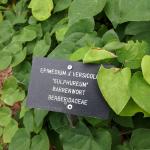 Leafcutter Bees: There are a few common genera and species of leafcutter bees (Family Megachilidae) that are known to North America. Some commonly recognized genera include Megachile and Osmia. Most leafcutter bees are approximately the size of a honey bee and are stout, black-bodied bees whose females carry pollen on the underside of their abdomens rather than on their hind legs like other species of bees. As their common name would imply, leafcutter bees cut ¼ to ½ inch circular slices out of plant leaves and use these pieces when constructing their solitary nests, as pictured here on Epimedium x versicolor ‘Sulphureum’ (bicolor barrenwort) on 7/3/2021 in Berkshire County, MA. Leafcutter bees look for suitable cavities (holes in wood and plant stems) in which they construct cigar-shaped nests that contain several cells. Females will deposit a single egg and pollen (to feed their growing larva that hatches from the egg) in each cell. Leafcutter bees are important pollinators, and are reluctant to sting people unless handled. They are beneficial insects, and should be preserved in our landscapes. The “damage” they cause to the plants whose leaves they use to line their nests is negligible, and should be tolerated and enjoyed.
Leafcutter Bees: There are a few common genera and species of leafcutter bees (Family Megachilidae) that are known to North America. Some commonly recognized genera include Megachile and Osmia. Most leafcutter bees are approximately the size of a honey bee and are stout, black-bodied bees whose females carry pollen on the underside of their abdomens rather than on their hind legs like other species of bees. As their common name would imply, leafcutter bees cut ¼ to ½ inch circular slices out of plant leaves and use these pieces when constructing their solitary nests, as pictured here on Epimedium x versicolor ‘Sulphureum’ (bicolor barrenwort) on 7/3/2021 in Berkshire County, MA. Leafcutter bees look for suitable cavities (holes in wood and plant stems) in which they construct cigar-shaped nests that contain several cells. Females will deposit a single egg and pollen (to feed their growing larva that hatches from the egg) in each cell. Leafcutter bees are important pollinators, and are reluctant to sting people unless handled. They are beneficial insects, and should be preserved in our landscapes. The “damage” they cause to the plants whose leaves they use to line their nests is negligible, and should be tolerated and enjoyed.
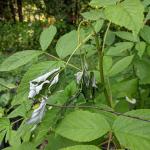 Raspberry Cane Borer: Oberea perspicillata (also sometimes referred to as Oberea bimaculata) is a beetle in the Family Cerambycidae (longhorned beetles) that is approximately ½ inch in length as an adult and mostly black in color, with the exception of a yellow thorax with two black spots. Adult females will create two rows of punctures in raspberry canes (stems) near the tips, in between which they deposit eggs. These rows of punctures cause the tip of the cane to wilt, due to the girdling of the stem, and is a typical first sign of the presence of these beetles in a backyard raspberry patch. Eggs hatch sometime in the summer and larvae bore several inches into the canes, and overwinter at ground level inside the plant, then pupating and emerging the next season as adults sometime in June. While at least two other boring pest insects from different families (Buprestidae and Sesiidae) cause damage to raspberry, the distinctive double row of punctures or two “rings” just below a wilting stem is indicative of the presence of the raspberry cane borer. Management of this insect in a raspberry patch is simple – prune and remove the portion of the stem from the wilted tip to at least below the second of the two lines, and throw this in the trash. Typically, this mechanical approach to management is all that is needed for this insect.
Raspberry Cane Borer: Oberea perspicillata (also sometimes referred to as Oberea bimaculata) is a beetle in the Family Cerambycidae (longhorned beetles) that is approximately ½ inch in length as an adult and mostly black in color, with the exception of a yellow thorax with two black spots. Adult females will create two rows of punctures in raspberry canes (stems) near the tips, in between which they deposit eggs. These rows of punctures cause the tip of the cane to wilt, due to the girdling of the stem, and is a typical first sign of the presence of these beetles in a backyard raspberry patch. Eggs hatch sometime in the summer and larvae bore several inches into the canes, and overwinter at ground level inside the plant, then pupating and emerging the next season as adults sometime in June. While at least two other boring pest insects from different families (Buprestidae and Sesiidae) cause damage to raspberry, the distinctive double row of punctures or two “rings” just below a wilting stem is indicative of the presence of the raspberry cane borer. Management of this insect in a raspberry patch is simple – prune and remove the portion of the stem from the wilted tip to at least below the second of the two lines, and throw this in the trash. Typically, this mechanical approach to management is all that is needed for this insect.
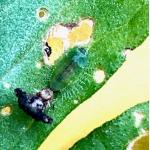
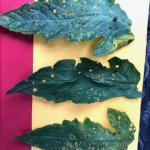 Tortoise Beetles: this tribe of insects (the Cassidini; Tortoise Beetles) are members of the Family Chrysomelidae (the leaf beetles). There are a couple of native species in this tribe whose larvae (immatures) are green in color and may be found feeding on tomato plants, as was reported with these photos from Plymouth County, MA on 7/7/2021. In Northeastern North America, the species of concern here is most likely Plagiometriona clavata or the Clavate Tortoise Beetle. (However, in states south of us Gratiana pallidula or the eggplant tortoise beetle also has spiny green larvae that feed on tomatoes, and other Solanum spp.) P. clavata may also be found feeding on pepper (Capsicum spp.), jimsonweed (Datura spp.), and nightshade (Solanum spp.). One of the most interesting features about tortoise beetles, including P. clavata, is the habit of the larvae collecting their own fecal matter on a forked structure that protrudes from the end of their abdomen. This fork is used to hold their excrement above the body like an umbrella. This fecal shield grows in size as the larva grows in size and seems to serve the purpose of a deterrent of predators, preventing them from attacking the larva. Typically, tortoise beetles are not found in high enough populations to cause significant damage, so management is not usually necessary.
Tortoise Beetles: this tribe of insects (the Cassidini; Tortoise Beetles) are members of the Family Chrysomelidae (the leaf beetles). There are a couple of native species in this tribe whose larvae (immatures) are green in color and may be found feeding on tomato plants, as was reported with these photos from Plymouth County, MA on 7/7/2021. In Northeastern North America, the species of concern here is most likely Plagiometriona clavata or the Clavate Tortoise Beetle. (However, in states south of us Gratiana pallidula or the eggplant tortoise beetle also has spiny green larvae that feed on tomatoes, and other Solanum spp.) P. clavata may also be found feeding on pepper (Capsicum spp.), jimsonweed (Datura spp.), and nightshade (Solanum spp.). One of the most interesting features about tortoise beetles, including P. clavata, is the habit of the larvae collecting their own fecal matter on a forked structure that protrudes from the end of their abdomen. This fork is used to hold their excrement above the body like an umbrella. This fecal shield grows in size as the larva grows in size and seems to serve the purpose of a deterrent of predators, preventing them from attacking the larva. Typically, tortoise beetles are not found in high enough populations to cause significant damage, so management is not usually necessary.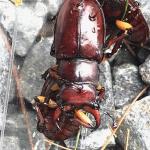

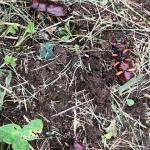 Yellow-thighed Stag Beetle: Lucanus capreolus or the yellow-thighed (also sometimes called the reddish-brown) stag beetle is a member of the Family Lucanidae (the stag beetles). Adults are large (just under an inch to 1.5 inches in length) and light to dark reddish brown with distinctly yellow femora (the thighs, or typically the longest segment of the insect leg). An interesting note about this species, as with other stag beetles, is dimorphism occurs between males (major and minor males) as well as females. This is such that major males have mandibles (mouthparts) that are as long as the pronotum (the structure covering the thorax or area right behind the head in beetles), and minor males as well as females have mouthparts that are shorter than the pronotum. Males use oversized mandibles (mouthparts) to engage in contests with rivals in order to mate with a nearby female. These beetles are common to deciduous hardwood forests, parks, and neighborhoods with mature trees. They may fly with a loud buzzing sound at dusk and are attracted to lights. Stag beetles typically lay their eggs in the crevices of logs and stumps, or among the roots of deciduous or coniferous trees. Their C-shaped larvae or grubs will then feed on the decaying wood and as such, these impressive beetles are not considered pests.
Yellow-thighed Stag Beetle: Lucanus capreolus or the yellow-thighed (also sometimes called the reddish-brown) stag beetle is a member of the Family Lucanidae (the stag beetles). Adults are large (just under an inch to 1.5 inches in length) and light to dark reddish brown with distinctly yellow femora (the thighs, or typically the longest segment of the insect leg). An interesting note about this species, as with other stag beetles, is dimorphism occurs between males (major and minor males) as well as females. This is such that major males have mandibles (mouthparts) that are as long as the pronotum (the structure covering the thorax or area right behind the head in beetles), and minor males as well as females have mouthparts that are shorter than the pronotum. Males use oversized mandibles (mouthparts) to engage in contests with rivals in order to mate with a nearby female. These beetles are common to deciduous hardwood forests, parks, and neighborhoods with mature trees. They may fly with a loud buzzing sound at dusk and are attracted to lights. Stag beetles typically lay their eggs in the crevices of logs and stumps, or among the roots of deciduous or coniferous trees. Their C-shaped larvae or grubs will then feed on the decaying wood and as such, these impressive beetles are not considered pests.
Insects and Other Arthropods of Medical Importance:
- Mosquitoes: The Massachusetts Department of Public Health announced on July 1, 2021 that West Nile virus (WNV) was detected in mosquitoes in Massachusetts for the first time this year in a sample collected on June 29 in the town of Medford, MA (Middlesex County). To date, no human or animal cases of WNV or Eastern Equine Encephalitis (EEE) have been detected so far in 2021. For more information, visit: https://www.mass.gov/news/state-public-health-officials-confirm-seasons-first-west-nile-virus-positive-mosquito-sample AND https://www.mass.gov/info-details/massachusetts-arbovirus-update .
According to the Massachusetts Bureau of Infectious Disease and Laboratory Science and the Department of Public Health, there are at least 51 different species of mosquito found in Massachusetts. Mosquitoes belong to the Order Diptera (true flies) and the Family Culicidae (mosquitoes). As such, they undergo complete metamorphosis, and possess four major life stages: egg, larva, pupa, and adult. Adult mosquitoes are the only stage that flies and many female mosquitoes only live for 2 weeks (although the life cycle and timing will depend upon the species). Only female mosquitoes bite to take a blood meal, and this is so they can make eggs. Mosquitoes need water to lay their eggs in, so they are often found in wet or damp locations and around plants. Different species prefer different habitats. It is possible to be bitten by a mosquito at any time of the day, and again timing depends upon the species. Many are particularly active from just before dusk, through the night, and until dawn. Mosquito bites are not only itchy and annoying, but they can be associated with greater health risks. Certain mosquitoes vector pathogens that cause diseases such as West Nile virus (WNV) and eastern equine encephalitis (EEE).
For more information about mosquitoes in Massachusetts, visit: https://www.mass.gov/service-details/mosquitoes-in-massachusetts
There are ways to protect yourself against mosquitoes, including wearing long-sleeved shirts and long pants, keeping mosquitoes outside by using tight-fitting window and door screens, and using insect repellents as directed. Products containing the active ingredients DEET, permethrin, IR3535, picaridin, and oil of lemon eucalyptus provide protection against mosquitoes.
For more information about mosquito repellents, visit: https://www.mass.gov/service-details/mosquito-repellents and https://www.cdc.gov/mosquitoes/mosquito-bites/prevent-mosquito-bites.html .
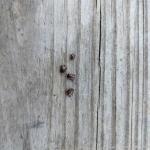
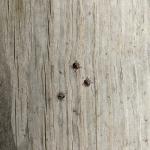 American Dog Tick: Anecdotally, Dermacentor variabilis has been prevalent in certain locations in Massachusetts in 2021. The images shown here are adult stage dog ticks removed from a dog following a roadside walk in Hampshire County on both 5/6/21 (4 ticks removed) and 5/7/21 (3 ticks removed). Looking for more updates? Check out UMass Extension’s Tick Check with Blake Dinius, Plymouth County Extension Service and Larry Dapsis, Cape Cod Cooperative Extension: https://www.youtube.com/watch?v=gryCv8qB1qw
American Dog Tick: Anecdotally, Dermacentor variabilis has been prevalent in certain locations in Massachusetts in 2021. The images shown here are adult stage dog ticks removed from a dog following a roadside walk in Hampshire County on both 5/6/21 (4 ticks removed) and 5/7/21 (3 ticks removed). Looking for more updates? Check out UMass Extension’s Tick Check with Blake Dinius, Plymouth County Extension Service and Larry Dapsis, Cape Cod Cooperative Extension: https://www.youtube.com/watch?v=gryCv8qB1qw
The American dog tick is found throughout most of North America. It may be encountered in forest edges, fields, along walkways and roadways, sidewalks, and trails. Adult stage ticks may be found on raccoons, skunks, cats, dogs, and other medium-sized hosts. Larvae and nymphs can be found on mice, voles, rats, and chipmunks. Adult males and females are active between April and early-August. Both adult males and females will feed, including on people. Nymphs and larvae of this species rarely attach to people or their pets. This species of tick can transmit lesser-known diseases such as Rocky Mountain Spotted Fever (not frequently infecting humans, according to CDC reports) and Tularemia (rarely infecting humans, according to CDC reports). For more information about the American dog tick, visit: https://web.uri.edu/tickencounter/species/dog-tick/ .
- Deer Tick/Blacklegged Tick: Check out the archived FREE TickTalk with TickReport webinars available here: https://ag.umass.edu/landscape/education-events/webinars .
*Ixodes scapularis - We are now in the time of year when deer tick larvae and nymphs are frequently encountered. Larvae may be encountered in April, but in some locations may peak in their activity in August, while still being encountered through November. Nymphs are encountered from April through July, peaking in June. Nymphs are again present in October and November. For images of all deer tick life stages, along with an outline of the diseases they carry, and their timing of activity, visit: http://www.tickencounter.org/tick_identification/deer_tick .
Anyone working in the yard and garden should be aware that there is the potential to encounter deer ticks. The deer tick or blacklegged tick can transmit Lyme disease, human babesiosis, human anaplasmosis, and other diseases. Preventative activities, such as daily tick checks, wearing appropriate clothing, and permethrin treatments for clothing (according to label instructions) can aid in reducing the risk that a tick will become attached to your body. If a tick cannot attach and feed, it will not transmit disease. For more information about personal protective measures, visit: http://www.tickencounter.org/prevention/protect_yourself .
The Center for Agriculture, Food, and the Environment provides a list of potential tick identification and testing resources here: https://ag.umass.edu/resources/tick-testing-resources
*Note that deer ticks (Ixodes scapularis) are not the only disease-causing tick species found in Massachusetts. The American dog tick (Dermacentor variabilis) and the lone star tick (Amblyomma americanum) are also found throughout MA. Each can carry their own complement of diseases, including others not mentioned above. Anyone working or playing in tick habitats (wood-line areas, forested areas, and landscaped areas with ground cover) should check themselves regularly for ticks while practicing preventative measures.
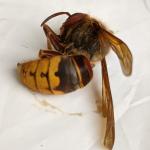
 Wasps/Hornets: Many wasps are predators of other arthropods, including pest insects such as certain caterpillars that feed on trees and shrubs. Adult wasps hunt prey and bring it back to their nest where young are being reared, as food for the immature wasps. A common such example are the paper wasps (Polistes spp.) who rear their young on chewed up insects. They may be seen searching plants for caterpillars and other soft-bodied larvae to feed their young. Paper wasps can sting, and will defend their nests, which are open-celled paper nests that are not covered with a papery “envelope”. These open-celled nests may be seen hanging from eaves or other outdoor building structures. Aerial yellow jackets and hornets create large aerial nests that are covered with a papery shell or “envelope”. Common yellow jacket species include those in the genus Vespula. Dolichovespula maculata is commonly known as the baldfaced hornet, although it is not a true hornet. The European hornet (Vespa crabro) is three times the size of a yellow jacket and may be confused for the Asian giant hornet (Vespa mandarinia). The European hornet is known to Massachusetts, but the Asian giant hornet is not. If you are concerned that you have found or photographed an Asian giant hornet, please report it here: https://massnrc.org/pests/report.aspx . Paper wasps and aerial yellowjackets overwinter as fertilized females (queens) and a single female produces a new nest annually in the late spring. Nests are abandoned at the end of the season. Queens start new nests, lay eggs, and rear new wasps to assist in colony/nest development.Some people are allergic to stinging insects, so care should be taken around wasp/hornet nests. Unlike the European honeybee (Apis mellifera), wasps and hornets do not have barbed stingers, and therefore can sting repeatedly when defending their nests. It is best to avoid their nests, and if that cannot be done and assistance is needed to remove them, consult a professional.
Wasps/Hornets: Many wasps are predators of other arthropods, including pest insects such as certain caterpillars that feed on trees and shrubs. Adult wasps hunt prey and bring it back to their nest where young are being reared, as food for the immature wasps. A common such example are the paper wasps (Polistes spp.) who rear their young on chewed up insects. They may be seen searching plants for caterpillars and other soft-bodied larvae to feed their young. Paper wasps can sting, and will defend their nests, which are open-celled paper nests that are not covered with a papery “envelope”. These open-celled nests may be seen hanging from eaves or other outdoor building structures. Aerial yellow jackets and hornets create large aerial nests that are covered with a papery shell or “envelope”. Common yellow jacket species include those in the genus Vespula. Dolichovespula maculata is commonly known as the baldfaced hornet, although it is not a true hornet. The European hornet (Vespa crabro) is three times the size of a yellow jacket and may be confused for the Asian giant hornet (Vespa mandarinia). The European hornet is known to Massachusetts, but the Asian giant hornet is not. If you are concerned that you have found or photographed an Asian giant hornet, please report it here: https://massnrc.org/pests/report.aspx . Paper wasps and aerial yellowjackets overwinter as fertilized females (queens) and a single female produces a new nest annually in the late spring. Nests are abandoned at the end of the season. Queens start new nests, lay eggs, and rear new wasps to assist in colony/nest development.Some people are allergic to stinging insects, so care should be taken around wasp/hornet nests. Unlike the European honeybee (Apis mellifera), wasps and hornets do not have barbed stingers, and therefore can sting repeatedly when defending their nests. It is best to avoid their nests, and if that cannot be done and assistance is needed to remove them, consult a professional.
Woody ornamental insect and non-insect arthropod pests to consider, a selected few:
Invasive Insects & Other Organisms Update:
 Spotted Lanternfly: (Lycorma delicatula, SLF) is not known to be established in Massachusetts landscapes at this time. However, due to the great ability of this insect to hitchhike using human-aided movement, it is important that we remain vigilant in Massachusetts and report any suspicious findings. Spotted lanternfly reports can be sent here: https://massnrc.org/pests/slfreport.aspx .
Spotted Lanternfly: (Lycorma delicatula, SLF) is not known to be established in Massachusetts landscapes at this time. However, due to the great ability of this insect to hitchhike using human-aided movement, it is important that we remain vigilant in Massachusetts and report any suspicious findings. Spotted lanternfly reports can be sent here: https://massnrc.org/pests/slfreport.aspx .
The Massachusetts Department of Agricultural Resources has recently released spotted lanternfly Best Management Practices for Nurseries and Landscapers: https://massnrc.org/pests/linkeddocuments/MANurseryBMPs.pdf
And Best Management Practices for Moving Companies and the Moving Industry: https://massnrc.org/pests/linkeddocuments/SLFChecklistMovingIndustryMA.pdf
Now is a great time to provide copies of these BMP’s to employees, customers, family, and friends! The more eyes we have out there looking for spotted lanternfly, the better. Use the above BMP’s as a guide to help you inspect certain items coming from CT, DE, MD, NC, NJ, NY, OH, PA, WV, and VA.
UMass Extension is teaming up with UMass Amherst’s Department of Environmental Conservation, the USDA APHIS, and the Massachusetts Department of Agricultural Resources to monitor for the spotted lanternfly in Massachusetts. A team including members of UMass Extension’s Landscape, Nursery, and Urban Forestry Program, Extension’s Fruit Program, Stockbridge School of Agriculture, and the Department of Environmental Conservation at UMass, Amherst are undertaking a nine-month integrated research and extension project to develop effective tools to detect the spotted lanternfly.
The researchers associated with this project (Dr. Joseph Elkinton, Dr. Jeremy Andersen and Dr. Jaime Pinero) will be working with Dr. Miriam Cooperband of the USDA APHIS lab on Cape Cod to identify and evaluate airborne attractants that can improve the ability to detect SLF in traps. Dr. Cooperband has identified several attractant lures released from host plants of SLF. She is currently working on pheromones produced by SLF that may be much more attractive. The UMass team will help her conduct field tests of these new lures, while also assisting the Massachusetts Department of Agricultural Resources (MDAR) in monitoring for SLF in Massachusetts. UMass Extension Entomologist, Tawny Simisky, will periodically report on progress made during the course of this project. For more information, please visit: https://ag.umass.edu/cafe/news/looking-for-spotted-lanternfly-recent-invasive-arrival
This insect is a member of the Order Hemiptera (true bugs, cicadas, hoppers, aphids, and others) and the Family Fulgoridae, also known as planthoppers. The spotted lanternfly is a non-native species first detected in the United States in Berks County, Pennsylvania and confirmed on September 22, 2014.
For a map of known, established populations of SLF as well as detections outside of these areas where individual finds of spotted lanternfly have occurred (but no infestations are present), visit: https://nysipm.cornell.edu/environment/invasive-species-exotic-pests/spotted-lanternfly/
The spotted lanternfly is considered native to China, India, and Vietnam. It has been introduced as a non-native insect to South Korea and Japan, prior to its detection in the United States. In South Korea, it is considered invasive and a pest of grapes and peaches. The spotted lanternfly has been reported feeding on over 103 species of plants, according to new research (Barringer and Ciafré, 2020) and when including not only plants on which the insect feeds, but those that it will lay egg masses on, this number rises to 172. This includes, but is not limited to, the following: tree of heaven (Ailanthus altissima) (preferred host), apple (Malus spp.), plum, cherry, peach, apricot (Prunus spp.), grape (Vitis spp.), pine (Pinus spp.), pignut hickory (Carya glabra), sassafras (Sassafras albidum), serviceberry (Amelanchier spp.), slippery elm (Ulmus rubra), tulip poplar (Liriodendron tulipifera), white ash (Fraxinus americana), willow (Salix spp.), American beech (Fagus grandifolia), American linden (Tilia americana), American sycamore (Platanus occidentalis), big-toothed aspen (Populus grandidentata), black birch (Betula lenta), black cherry (Prunus serotina), black gum (Nyssa sylvatica), black walnut (Juglans nigra), dogwood (Cornus spp.), Japanese snowbell (Styrax japonicus), maple (Acer spp.), oak (Quercus spp.), and paper birch (Betula papyrifera).
The adults and immatures of this species damage host plants by feeding on sap from stems, leaves, and the trunks of trees. In the springtime in Pennsylvania (late April - mid-May) nymphs (immatures) are found on smaller plants and vines and new growth of trees and shrubs. Third and fourth instar nymphs migrate to the tree of heaven and are observed feeding on trunks and branches. Trees may be found with sap weeping from the wounds caused by the insect’s feeding. The sugary secretions (excrement) created by this insect may coat the host plant, later leading to the growth of sooty mold. Insects such as wasps, hornets, bees, and ants may also be attracted to the sugary waste created by the lanternflies, or sap weeping from open wounds in the host plant. Host plants have been described as giving off a fermented odor when this insect is present.
Adults are present by the middle of July in Pennsylvania and begin laying eggs by late September and continue laying eggs through late November and even early December in that state. Adults may be found on the trunks of trees such as the tree of heaven or other host plants growing in close proximity to them. Egg masses of this insect are gray in color and look similar in some ways to gypsy moth egg masses.
Host plants, bricks, stone, lawn furniture, recreational vehicles, and other smooth surfaces can be inspected for egg masses. Egg masses laid on outdoor residential items such as those listed above may pose the greatest threat for spreading this insect via human aided movement.
For more information about the spotted lanternfly, visit this fact sheet: https://ag.umass.edu/landscape/fact-sheets/spotted-lanternfly .
- Emerald Ash Borer: (Agrilus planipennis, EAB) in 2021 alone, the Massachusetts Department of Conservation and Recreation has confirmed at least 28 new community detections of emerald ash borer in Massachusetts. To date, 11 out of the 14 counties in Massachusetts have confirmed emerald ash borer. (The remaining counties where EAB has yet to be detected are Barnstable, Dukes, and Nantucket counties.)A map of these locations and others previously known across the state may be found here: https://ag.umass.edu/fact-sheets/emerald-ash-borer .
This wood-boring beetle readily attacks ash (Fraxinus spp.) including white, green, and black ash and has also been found developing in white fringe tree (Chionanthus virginicus) and has been reported in cultivated olive (Olea europaea). Adult insects of this species will not be present at this time of year. Signs of an EAB infested tree may include (at this time) D-shaped exit holes in the bark (from adult emergence in previous years), “blonding” or lighter coloration of the ash bark from woodpecker feeding (chipping away of the bark as they search for larvae beneath), and serpentine galleries visible through splits in the bark, from larval feeding beneath. It is interesting to note that woodpeckers are capable of eating 30-95% of the emerald ash borer larvae found in a single tree (Murphy et al. 2018). Unfortunately, despite high predation rates, EAB populations continue to grow.
For further information about this insect, please visit: https://ag.umass.edu/fact-sheets/emerald-ash-borer . If you believe you have located EAB-infested ash trees, particularly in an area of Massachusetts not identified on the map provided, please report here: https://massnrc.org/pests/eabreport.htm .
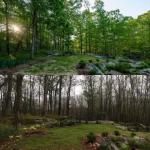
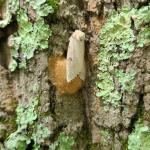
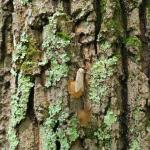 Gypsy Moth:(Lymantria dispar) thanks to the gypsy moth caterpillar killing fungus, Entomophaga maimaiga, the recent widespread outbreak of gypsy moth in Massachusetts has come to an end! Most locations in Massachusetts have not seen damaging or even noticeable populations of this insect in 2021. However, there have been reports of gypsy moth caterpillars feeding on susceptible hosts in some locations in western Massachusetts, particularly in parts of Berkshire County (ex. Alford, Great Barrington, Richmond, Sheffield, South Egremont, and Williamstown). (Ex. On 6/9/21, a report from Great Barrington, MA noted that caterpillars were defoliating trees in a forested area, and that caterpillar frass (excrement) was seen raining down from the canopy.) While this may be the case in certain locations, we do not expect widespread defoliation (to the extent that we saw in 2017) from this insect in 2021 in MA. Another note for 6/9/2021: there have been reports of increased gypsy moth activity in certain locations in New York. Massachusetts residents vacationing or with second homes in that state are reporting defoliation on oaks and pines in NY. For more information, visit: https://www.dec.ny.gov/animals/83118.html . An update from 6/22/2021: defoliation of the canopy has been observed by professionals working in Litchfield County, CT. On 7/7/2021, professionals working in the Sharon and West Cornwall areas of CT, parts of Berkshire County, MA, and parts of Columbia County, NY are reporting defoliation caused by gypsy moth caterpillars. On 7/7/2021, hundreds of gypsy moth males were reported flying in Sheffield, MA (Berkshire County) and mating with adult females who were also laying egg masses on trees. Reports indicate that some caterpillars are just getting ready to pupate, others have pupated, and adults have emerged. Gypsy moth caterpillar feeding is at an end for the 2021 growing season in these locations.
Gypsy Moth:(Lymantria dispar) thanks to the gypsy moth caterpillar killing fungus, Entomophaga maimaiga, the recent widespread outbreak of gypsy moth in Massachusetts has come to an end! Most locations in Massachusetts have not seen damaging or even noticeable populations of this insect in 2021. However, there have been reports of gypsy moth caterpillars feeding on susceptible hosts in some locations in western Massachusetts, particularly in parts of Berkshire County (ex. Alford, Great Barrington, Richmond, Sheffield, South Egremont, and Williamstown). (Ex. On 6/9/21, a report from Great Barrington, MA noted that caterpillars were defoliating trees in a forested area, and that caterpillar frass (excrement) was seen raining down from the canopy.) While this may be the case in certain locations, we do not expect widespread defoliation (to the extent that we saw in 2017) from this insect in 2021 in MA. Another note for 6/9/2021: there have been reports of increased gypsy moth activity in certain locations in New York. Massachusetts residents vacationing or with second homes in that state are reporting defoliation on oaks and pines in NY. For more information, visit: https://www.dec.ny.gov/animals/83118.html . An update from 6/22/2021: defoliation of the canopy has been observed by professionals working in Litchfield County, CT. On 7/7/2021, professionals working in the Sharon and West Cornwall areas of CT, parts of Berkshire County, MA, and parts of Columbia County, NY are reporting defoliation caused by gypsy moth caterpillars. On 7/7/2021, hundreds of gypsy moth males were reported flying in Sheffield, MA (Berkshire County) and mating with adult females who were also laying egg masses on trees. Reports indicate that some caterpillars are just getting ready to pupate, others have pupated, and adults have emerged. Gypsy moth caterpillar feeding is at an end for the 2021 growing season in these locations.
Gypsy moth has been in Massachusetts since the 1860's. This invasive insect from Europe often goes unnoticed, thanks to population regulation provided by the entomopathogenic fungus, E. maimaiga, as well as a NPV virus specific to gypsy moth caterpillars. (And to a lesser extent many other organisms, including other insects, small mammals, and birds who feed on gypsy moth.) However, if environmental conditions do not favor the life cycle of the fungus, outbreaks of gypsy moth caterpillars are possible. (Such as most recently from 2015-2018, with a peak in the gypsy moth population in 2017 in Massachusetts.)
Check out Episode 1 of InsectXaminer to reminisce about the 2015-2018 outbreak of this insect and learn more about the fungus and the virus and how to recognize caterpillars that have been killed by these pathogens: https://ag.umass.edu/landscape/education-events/insectxaminer
- Asian Longhorned Beetle: (Anoplophora glabripennis, ALB) Look for signs of an ALB infestation which include perfectly round exit holes (about the size of a dime), shallow oval or round scars in the bark where a female has chewed an egg site, or sawdust-like frass (excrement) on the ground nearby host trees or caught in between branches. Be advised that other, native insects may create perfectly round exit holes or sawdust-like frass, which can be confused with signs of ALB activity.
The regulated area for Asian longhorned beetle is 110 miles2 encompassing Worcester, Shrewsbury, Boylston, West Boylston, and parts of Holden and Auburn. If you believe you have seen damage caused by this insect, such as exit holes or egg sites, on susceptible host trees like maple, please call the Asian Longhorned Beetle Eradication Program office in Worcester, MA at 508-852-8090 or toll free at 1-866-702-9938.
To report an Asian longhorned beetle find online or compare it to common insect look-alikes, visit: http://massnrc.org/pests/albreport.aspx or https://www.aphis.usda.gov/pests-diseases/alb/report .
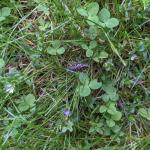
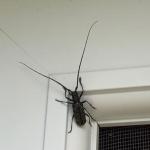 White Spotted Pine Sawyer (WSPS): Monochamus scutellatus adults emerge in late May throughout July, depending on local temperatures. This is a native insect in Massachusetts and is usually not a pest. Larvae develop in weakened or recently dead conifers, particularly eastern white pine (Pinus strobus). However, the white spotted pine sawyer looks very similar to the invasive Asian Longhorned Beetle, Anoplophora glabripennis, ALB. ALB adults do not emerge in Massachusetts until July and August. Beginning in July, look for the key difference between WSPS and ALB adults, which is a white spot in the top center of the wing covers (the scutellum) on the back of the beetle. White spotted pine sawyer will have this white spot, whereas Asian longhorned beetle will not. Both insects can have other white spots on the rest of their wing covers; however, the difference in the color of the scutellum is a key characteristic. See the Asian longhorned beetle entry above for more information about that non-native insect.
White Spotted Pine Sawyer (WSPS): Monochamus scutellatus adults emerge in late May throughout July, depending on local temperatures. This is a native insect in Massachusetts and is usually not a pest. Larvae develop in weakened or recently dead conifers, particularly eastern white pine (Pinus strobus). However, the white spotted pine sawyer looks very similar to the invasive Asian Longhorned Beetle, Anoplophora glabripennis, ALB. ALB adults do not emerge in Massachusetts until July and August. Beginning in July, look for the key difference between WSPS and ALB adults, which is a white spot in the top center of the wing covers (the scutellum) on the back of the beetle. White spotted pine sawyer will have this white spot, whereas Asian longhorned beetle will not. Both insects can have other white spots on the rest of their wing covers; however, the difference in the color of the scutellum is a key characteristic. See the Asian longhorned beetle entry above for more information about that non-native insect.- Jumping Worms: In recent years, public concern about Amynthas spp. earthworms, collectively referred to as “jumping or crazy or snake” worms, has dramatically increased. University researchers and Extension groups in many locations in the US are finding that these species cause not only forest ecosystem disturbances, but may also negatively impact soil structure and reduce plant growth in gardens and managed landscapes. They do this by voraciously devouring the organic layer of the soil while feeding very close to the soil surface, unlike other species of earthworms. In woodland areas, they can quickly eat all of the leaf litter on the forest floor. Jumping worms also leave a distinct grainy soil full of worm castings. The soil becomes granular and may look like dried coffee grounds.
Unfortunately, there are currently no research-based management options available for these earthworms. So prevention is essential – preventing their introduction and spread into new areas is the best defense against them. Adult jumping worms can be 1.5 – 8 inches or more in length. Their clitellum (collar-like ring) is roughly located 1/3 down the length of the worm (from the head) and is smooth and cloudy-white and constricted. These worms may also wiggle or jump when disturbed, and can move across the ground in an S-shape like a snake. While the exact timing of their life cycle in MA might not be completely understood, their life cycle may be expected to go (roughly) something like this: they hatch in the late spring in 1-4 inches of soil, mature into adults during the summer and adults lay eggs sometime in August, and it is thought that their cocoons overwinter. (Adults perish with frost.) It is also worth noting here that jumping worms do not directly harm humans or pets.
For more information, listen to Dr. Olga Kostromytska’s presentation here: https://ag.umass.edu/landscape/education-events/invasive-insect-webinars
Suggested reading includes Dr. Kostromytska’s recent “Hot Topics” article in Hort Notes (including an identification guide), here: https://ag.umass.edu/landscape/newsletters/hort-notes/hort-notes-2021-vol-323
Additional resources can also be found here:
University of Minnesota Extension: https://extension.umn.edu/identify-invasive-species/jumping-worms
Cornell Cooperative Extension: http://ulster.cce.cornell.edu/environment/invasive-pests/jumping-worm
UNH Extension: https://extension.unh.edu/blog/invasive-spotlight-jumping-worms
Tree & Shrub Insects & Mites:
- Arborvitae Leafminer: In New England and eastern Canada, four species of leafminers are known to infest arborvitae. These include Argyresthia thuiella, A. freyella, A. aureoargentella, and Coleotechnites thujaella. The arborvitae leafminer, A. thuiella, is the most abundant of these and has the greatest known range when compared to the others. (It is also found in the Mid-Atlantic States and as far west as Missouri). Moths of this species appear from mid-June to mid-July and lay their eggs. The damage caused by all of these species is nearly identical. Trees, however, have been reported to lose up to 80% of their foliage due to arborvitae leafminer and still survive. At least 27 species of parasites have been reported as natural enemies of arborvitae leafminers, the most significant of which may be a parasitic wasp (Pentacnemus bucculatricis). Arborvitae leafminer damage causes the tips of shoots and foliage to turn yellow and brown. If infestations are light, prune out infested tips.

 Azalea Sawflies: There are a few species of sawflies that impact azaleas. Johnson and Lyon's Insects that Feed on Trees and Shrubs mentions three of them. Amauronematus azaleae was first reported in New Hampshire in 1895 and is likely found in most of New England. Adults of this species are black with some white markings and wasp-like. Generally green larvae feed mostly on mollis hybrid azaleas. Remember, sawfly caterpillars have at least enough abdominal prolegs to spell “sawfly” (so 6 or more prolegs). Adults are present in May, and females lay their eggs and then larvae hatch and feed through the end of June. There is one generation per year. Nematus lipovskyi has been reared from swamp azalea (Rhododendron viscosum). Adults of that species have been collected in April (in states to the south) and May (in New England) and larval feeding is predominantly in late April and May in Virginia and June in New England. One generation of this species occurs per year, and most mollis hybrid azaleas can be impacted. A third species, Arge clavicornis, is found as an adult in July and lays its eggs in leaf edges in rows. Larvae are present in August and September. Remember, Bacillus thuringiensis Kurstaki does not manage sawflies.
Azalea Sawflies: There are a few species of sawflies that impact azaleas. Johnson and Lyon's Insects that Feed on Trees and Shrubs mentions three of them. Amauronematus azaleae was first reported in New Hampshire in 1895 and is likely found in most of New England. Adults of this species are black with some white markings and wasp-like. Generally green larvae feed mostly on mollis hybrid azaleas. Remember, sawfly caterpillars have at least enough abdominal prolegs to spell “sawfly” (so 6 or more prolegs). Adults are present in May, and females lay their eggs and then larvae hatch and feed through the end of June. There is one generation per year. Nematus lipovskyi has been reared from swamp azalea (Rhododendron viscosum). Adults of that species have been collected in April (in states to the south) and May (in New England) and larval feeding is predominantly in late April and May in Virginia and June in New England. One generation of this species occurs per year, and most mollis hybrid azaleas can be impacted. A third species, Arge clavicornis, is found as an adult in July and lays its eggs in leaf edges in rows. Larvae are present in August and September. Remember, Bacillus thuringiensis Kurstaki does not manage sawflies.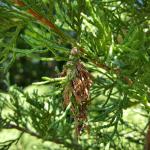 Bagworm: Thyridopteryx ephemeraeformis is a native species of moth whose larvae construct bag-like coverings over themselves with host plant leaves and twigs. This insect overwinters in the egg stage, within the bags of deceased females from last season. Eggs have hatched and very small, young larvae are observed feeding, as is typical around mid-June, or roughly between 600-900 GDD’s, but will quickly grow in size. In certain areas across MA in 2020, increased populations of bagworms were observed and reported, particularly in urban forest settings and managed landscapes. More information can be found here: https://ag.umass.edu/landscape/fact-sheets/bagworm
Bagworm: Thyridopteryx ephemeraeformis is a native species of moth whose larvae construct bag-like coverings over themselves with host plant leaves and twigs. This insect overwinters in the egg stage, within the bags of deceased females from last season. Eggs have hatched and very small, young larvae are observed feeding, as is typical around mid-June, or roughly between 600-900 GDD’s, but will quickly grow in size. In certain areas across MA in 2020, increased populations of bagworms were observed and reported, particularly in urban forest settings and managed landscapes. More information can be found here: https://ag.umass.edu/landscape/fact-sheets/bagworm- Cottony Taxus Scale: Pulvinaria floccifera, also referred to as the cottony camellia scale, utilizes such hosts as taxus, camellia, holly, hydrangea, Japanese maple, euonymus, magnolia, and jasmine, among others. Females have laid the long, narrow, white and fluffy egg sac that makes them much more noticeable. Eggs will hatch over an extended period of 6 weeks and crawlers may be treated between 802-1388 GDD’s. This insect can cause the host to appear off-color. They also produce honeydew which promotes sooty mold growth. Dieback is not common with this insect. Target the underside of the foliage. Horticultural oil, neem oil, and insecticidal soaps may be used to manage these soft scales. Reduced risk options help preserve natural enemies.
- Dogwood Borer: Synanthedon scitula is a species of clearwing moth whose larvae bore not only into dogwood (Cornus), but hosts also include flowering cherry, chestnut, apple, mountain ash, hickory, pecan, willow, birch, bayberry, oak, hazel, myrtle, and others. Kousa dogwood appear to be resistant to this species. Signs include the sloughing of loose bark, brown frass, particularly near bark cracks and wounds, dead branches, and adventitious growth. The timing of adult emergence can be expected when dogwood flower petals are dropping and weigela begins to bloom. Adult moth flights continue from then until September. Emergence in some hosts (ex. apple) appears to be delayed, but this differs depending upon the location in this insect’s range. Eggs are laid singly, or in small groups, on smooth and rough bark. Female moths preferentially lay eggs near wounded bark. After hatch, larvae wander until they find a suitable entrance point into the bark. This includes wounds, scars, or branch crotches. This insect may also be found in twig galls caused by other insects or fungi. Larvae feed on phloem and cambium. Fully grown larvae are white with a light brown head and approx. ½ inch long. Pheromone traps and lures are useful for determining the timing of adult moth emergence and subsequent management.

 Dogwood Sawfly: Macremphytus tarsatus larvae are commonly seen feeding on dogwoods, especially gray dogwood (Cornus racemosa). One generation occurs per year. The larvae of the dogwood sawfly overwinter in decaying wood and occasionally (rarely) compromised structural timber. An overwintering “cell” is created in this soft wood. Pupation occurs in the springtime and adults can take a lengthy time to emerge, roughly from late May through July. 100+ eggs are laid in groups on the underside of leaves. Eggs hatch and the larvae feed gregariously, initially skeletonizing the leaves. As the caterpillars grow in size, they are capable of eating the entire leaf, leaving only midveins behind. Larval appearance varies greatly throughout instars. Early instars are translucent and yellow, but as the caterpillars grow, they develop black spots (over the yellow) and become covered in a white powder-like material. Larvae and their shed skins may resemble bird droppings. Full-grown larvae begin to wander in search of a suitable overwintering location. Rotting wood lying on the ground is preferred for this. Sawfly caterpillars can be collected from plants and dropped into a can of soapy water.
Dogwood Sawfly: Macremphytus tarsatus larvae are commonly seen feeding on dogwoods, especially gray dogwood (Cornus racemosa). One generation occurs per year. The larvae of the dogwood sawfly overwinter in decaying wood and occasionally (rarely) compromised structural timber. An overwintering “cell” is created in this soft wood. Pupation occurs in the springtime and adults can take a lengthy time to emerge, roughly from late May through July. 100+ eggs are laid in groups on the underside of leaves. Eggs hatch and the larvae feed gregariously, initially skeletonizing the leaves. As the caterpillars grow in size, they are capable of eating the entire leaf, leaving only midveins behind. Larval appearance varies greatly throughout instars. Early instars are translucent and yellow, but as the caterpillars grow, they develop black spots (over the yellow) and become covered in a white powder-like material. Larvae and their shed skins may resemble bird droppings. Full-grown larvae begin to wander in search of a suitable overwintering location. Rotting wood lying on the ground is preferred for this. Sawfly caterpillars can be collected from plants and dropped into a can of soapy water.
 Elm Casebearer: Coleophora ulmifoliella is a native North American moth that is found throughout New England and west to Michigan. Host plants include American, red, and slippery elm. Moths are tiny, with wing spans of approximately 13 mm. and buff in color with gray markings. According to Johnson and Lyon’s “Insects that Feed on Trees and Shrubs”, adult moths fly and mate and females lay eggs in July, at which point the eggs hatch and the larvae of the insect enter the host plant leaves to feed as miners between the epidermal layers of the leaf. As the larva grows in size, it emerges from the leaf it was mining and creates a case, which grows in size with it. This case serves as a protective covering, which the larva adorns itself with through the rest of the larval stage. Mines look like rectangular spots in the leaves that are brown in color. As the weather cools in the fall, the casebearer larva migrates to the twigs of its host plant, where it ties the case in one location to spend the winter as an immature larva. The following spring, the casebearer migrates to new leaves and resumes feeding as a miner, however it does this while dragging its case behind it and never allowing its body to completely leave the case. Elm casebearer cases are approximately 6 mm. in length. Once fully mature, the larvae pupate (within their individual cases) and adult moths emerge in July. A single generation occurs per year.
Elm Casebearer: Coleophora ulmifoliella is a native North American moth that is found throughout New England and west to Michigan. Host plants include American, red, and slippery elm. Moths are tiny, with wing spans of approximately 13 mm. and buff in color with gray markings. According to Johnson and Lyon’s “Insects that Feed on Trees and Shrubs”, adult moths fly and mate and females lay eggs in July, at which point the eggs hatch and the larvae of the insect enter the host plant leaves to feed as miners between the epidermal layers of the leaf. As the larva grows in size, it emerges from the leaf it was mining and creates a case, which grows in size with it. This case serves as a protective covering, which the larva adorns itself with through the rest of the larval stage. Mines look like rectangular spots in the leaves that are brown in color. As the weather cools in the fall, the casebearer larva migrates to the twigs of its host plant, where it ties the case in one location to spend the winter as an immature larva. The following spring, the casebearer migrates to new leaves and resumes feeding as a miner, however it does this while dragging its case behind it and never allowing its body to completely leave the case. Elm casebearer cases are approximately 6 mm. in length. Once fully mature, the larvae pupate (within their individual cases) and adult moths emerge in July. A single generation occurs per year.
Damage from a single elm casebearer larva is negligible and does not require management. However, on occasion, elevated populations of this insect do occur and noticeable injury to host plant leaves can transpire. Complete browning and death of leaves can occur, if high populations are present. Chemical management of this native insect is not necessary unless the majority of leaves contain more than a single larva.
- Elongate Hemlock Scale: Fiorinia externa is found on eastern, Carolina, and Japanese hemlock, as well as yew, spruce, and fir. The elongate hemlock scale may overwinter in various life stages, and overlap of many developmental stages at any given time can be observed throughout much of the season. Nitrogen fertilizer applications may make elongate hemlock scale infestations worse.
 Fall Webworm: Hyphantria cunea is native to North America and Mexico. It is now considered a world-wide pest, as it has spread throughout much of Europe and Asia. (For example, it was introduced accidentally into Hungary from North America in the 1940’s.) Hosts include nearly all shade, fruit, and ornamental trees except conifers. In the USA, at least 88 species of trees are hosts for these insects, while in Europe at least 230 species are impacted. In the past history of this pest, it was once thought that the fall webworm was a two-species complex. It is now thought that H. cunea has two color morphs – one black headed and one red headed. These two color forms differ not only in the coloration of the caterpillars and the adults, but also in their behaviors. Caterpillars may go through at least 11 molts, each stage occurring within a silken web they produce over the host. When alarmed, all caterpillars in the group will move in unison in jerking motions that may be a mechanism for self-defense. Depending upon the location and climate, 1-4 generations of fall webworm can occur per year. Fall webworm adult moths lay eggs on the underside of the leaves of host plants in the spring. These eggs hatch in late June or early July depending on climate. Young larvae feed together in groups on the undersides of leaves, first skeletonizing the leaf and then enveloping other leaves and eventually entire branches within their webs. Webs are typically found on the terminal ends of branches. All caterpillar activity occurs within this tent, which becomes filled with leaf fragments, cast skins, and frass. Fully grown larvae then wander from the webs and pupate in protected areas such as the leaf litter where they will remain for the winter. Adult fall webworm moths emerge the following spring/early summer to start the cycle over again. 50+ species of parasites and 36+ species of predators are known to attack fall webworm in North America. Fall webworms typically do not cause extensive damage to their hosts. Nests may be an aesthetic issue for some. If in reach, small fall webworm webs may be pruned out of trees and shrubs and destroyed. Do not set fire to H. cunea webs when they are still attached to the host plant.
Fall Webworm: Hyphantria cunea is native to North America and Mexico. It is now considered a world-wide pest, as it has spread throughout much of Europe and Asia. (For example, it was introduced accidentally into Hungary from North America in the 1940’s.) Hosts include nearly all shade, fruit, and ornamental trees except conifers. In the USA, at least 88 species of trees are hosts for these insects, while in Europe at least 230 species are impacted. In the past history of this pest, it was once thought that the fall webworm was a two-species complex. It is now thought that H. cunea has two color morphs – one black headed and one red headed. These two color forms differ not only in the coloration of the caterpillars and the adults, but also in their behaviors. Caterpillars may go through at least 11 molts, each stage occurring within a silken web they produce over the host. When alarmed, all caterpillars in the group will move in unison in jerking motions that may be a mechanism for self-defense. Depending upon the location and climate, 1-4 generations of fall webworm can occur per year. Fall webworm adult moths lay eggs on the underside of the leaves of host plants in the spring. These eggs hatch in late June or early July depending on climate. Young larvae feed together in groups on the undersides of leaves, first skeletonizing the leaf and then enveloping other leaves and eventually entire branches within their webs. Webs are typically found on the terminal ends of branches. All caterpillar activity occurs within this tent, which becomes filled with leaf fragments, cast skins, and frass. Fully grown larvae then wander from the webs and pupate in protected areas such as the leaf litter where they will remain for the winter. Adult fall webworm moths emerge the following spring/early summer to start the cycle over again. 50+ species of parasites and 36+ species of predators are known to attack fall webworm in North America. Fall webworms typically do not cause extensive damage to their hosts. Nests may be an aesthetic issue for some. If in reach, small fall webworm webs may be pruned out of trees and shrubs and destroyed. Do not set fire to H. cunea webs when they are still attached to the host plant.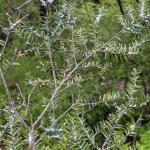
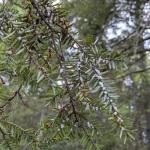
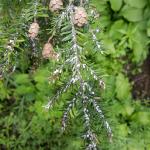 Hemlock Woolly Adelgid: Adelges tsugae is present on eastern and Carolina hemlock. The overwintering hemlock woolly adelgid generation (sistens) is present through mid-spring and produces the spring generation (progrediens) which will be present from early spring through mid-summer. HWA, unlike many other insects, does most of its feeding over the winter. Eggs may be found in woolly masses at the base of hemlock needles beginning in mid-March. Each woolly mass is created by a female who may then lay 50-300 eggs. Eggs hatch and crawlers may be found from mid-March through mid-July. Infested trees may be treated with foliar sprays in late April to early May, using Japanese quince as a phenological indicator. Systemic applications may be made in the spring and fall, or when soil conditions are favorable for translocation to foliage. Nitrogen fertilizer applications may make hemlock woolly adelgid infestations worse.
Hemlock Woolly Adelgid: Adelges tsugae is present on eastern and Carolina hemlock. The overwintering hemlock woolly adelgid generation (sistens) is present through mid-spring and produces the spring generation (progrediens) which will be present from early spring through mid-summer. HWA, unlike many other insects, does most of its feeding over the winter. Eggs may be found in woolly masses at the base of hemlock needles beginning in mid-March. Each woolly mass is created by a female who may then lay 50-300 eggs. Eggs hatch and crawlers may be found from mid-March through mid-July. Infested trees may be treated with foliar sprays in late April to early May, using Japanese quince as a phenological indicator. Systemic applications may be made in the spring and fall, or when soil conditions are favorable for translocation to foliage. Nitrogen fertilizer applications may make hemlock woolly adelgid infestations worse.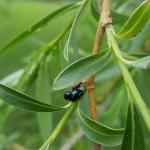
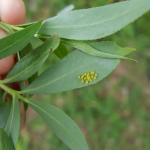 Imported Willow Leaf Beetle: Plagiodera versicolora adult beetles overwinter near susceptible hosts. Adult beetles will chew holes and notches in the leaves of willow once they become available. Females lay yellow eggs in clusters on the undersides of leaves. Larvae are slug-like and bluish-green in color. They will feed in clusters and skeletonize the leaves. Most plants can tolerate the feeding from this insect, and foliage will appear brown. Repeated yearly feeding can be an issue, in which case management of the young larvae may be necessary. Take care with treatment in areas near water.
Imported Willow Leaf Beetle: Plagiodera versicolora adult beetles overwinter near susceptible hosts. Adult beetles will chew holes and notches in the leaves of willow once they become available. Females lay yellow eggs in clusters on the undersides of leaves. Larvae are slug-like and bluish-green in color. They will feed in clusters and skeletonize the leaves. Most plants can tolerate the feeding from this insect, and foliage will appear brown. Repeated yearly feeding can be an issue, in which case management of the young larvae may be necessary. Take care with treatment in areas near water.
Check out Episode 4 of InsectXaminer to see the imported willow leaf beetle in action and learn more about its life cycle: https://ag.umass.edu/landscape/education-events/insectxaminer
- Lacebugs: Stephanitis spp. lacebugs such as S. pyriodes can cause severe injury to azalea foliage. S. rhododendri can be common on rhododendron and mountain laurel. S. takeyai has been found developing on Japanese andromeda, leucothoe, styrax, and willow. Stephanitis spp. lace bug activity should be monitored through September. Before populations become too large, treat with a summer rate horticultural oil spray as needed. Be sure to target the undersides of the foliage in order to get proper coverage of the insects. Certain azalea and andromeda cultivars may be less preferred by lace bugs.
- Lilac Borer: Podosesia syringae is a clearwing moth pest of lilac, privet, fringetree, and ash. (It is also known as the ash borer, not to be confused with the emerald ash borer.) Adults mimic paper wasps. Larvae are wood-boring, and signs and symptoms include branch dieback, holes, and occasionally, sawdust-like frass accumulated on bark. Larvae bore into stems, trunks, and branches, chewing an irregularly shaped entrance hole. Peak adult moth flights may occur in the northern portion of this insect’s range in June and is usually over by August 1st. Pheromone traps can be used to time adult emergence. Adult females lay flattened, oval, and tan eggs that are deposited singly or in clusters on bark crevices, ridges, and sometimes smooth bark; but usually laid in or near wounds in the bark. On average, 395 eggs are laid by each female. After hatch, larvae chew into the bark and feed laterally and then vertically in phloem tissue. Larvae overwinter in tunnels in the final instar and resume feeding in the spring. Adults emerge through a round exit hole (4-5 mm. in diameter). This insectmay be targeted between 200-299 GDD’s, base 50°F.

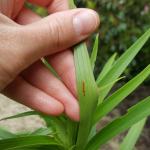
 Lily Leaf Beetle: Lilioceris lilii adults overwinter in sheltered places. As soon as susceptible hosts such as Lilium spp. (Turk’s cap, tiger, Easter, Asiatic, and Oriental lilies) and Fritillaria spp. break through the ground, the adult lily leaf beetles are known to feed on the new foliage. (Note: daylilies are not hosts.) Typically, in May, mating will occur and each female will begin to lay 250-450 eggs in neat rows on the underside of the foliage. If there are only a few plants in the garden, hand picking and destroying overwintering adults can help reduce local garden-level populations at that time. As eggs hatch and growing larvae begin to feed, the larvae of this insect can be removed from plants as well.
Lily Leaf Beetle: Lilioceris lilii adults overwinter in sheltered places. As soon as susceptible hosts such as Lilium spp. (Turk’s cap, tiger, Easter, Asiatic, and Oriental lilies) and Fritillaria spp. break through the ground, the adult lily leaf beetles are known to feed on the new foliage. (Note: daylilies are not hosts.) Typically, in May, mating will occur and each female will begin to lay 250-450 eggs in neat rows on the underside of the foliage. If there are only a few plants in the garden, hand picking and destroying overwintering adults can help reduce local garden-level populations at that time. As eggs hatch and growing larvae begin to feed, the larvae of this insect can be removed from plants as well.
Check out Episode 3 of InsectXaminer to see the lily leaf beetle in action and learn more about its life cycle: https://ag.umass.edu/landscape/education-events/insectxaminer
 Magnolia Scale: Neolecanium cornuparvum is a soft scale that overwinters as first instar nymphs which are elliptical, and dark slate gray in color and can usually be found on the undersides of 1 and 2 year old twigs. Nymphs may molt by late April or May and again by early June at which time the scales may be purple in color. Eventually nymphs secrete a white powdery layer of wax over their bodies. On magnolia hosts, these large soft scales could either be Neolecanium cornuparvum, the magnolia scale, or Toumeyella liriodendri, the tuliptree scale. The tuliptree scale can be found both on magnolia and tuliptree hosts, whereas the magnolia scale is only known to magnolia. Differentiation between these two species of scale (on magnolia) can be difficult in the field. Soft scale nymphs were found on 6/23/2021 in Hampshire County, MA on Magnolia stellata ‘Royal Star’. A coating of black sooty mold also covered stems and twigs. Natural enemies of soft scales and other pests were also present- the mealybug destroyer (Cryptolaemus montrouzieri) and Hyperaspis spp. ladybeetle larvae.
Magnolia Scale: Neolecanium cornuparvum is a soft scale that overwinters as first instar nymphs which are elliptical, and dark slate gray in color and can usually be found on the undersides of 1 and 2 year old twigs. Nymphs may molt by late April or May and again by early June at which time the scales may be purple in color. Eventually nymphs secrete a white powdery layer of wax over their bodies. On magnolia hosts, these large soft scales could either be Neolecanium cornuparvum, the magnolia scale, or Toumeyella liriodendri, the tuliptree scale. The tuliptree scale can be found both on magnolia and tuliptree hosts, whereas the magnolia scale is only known to magnolia. Differentiation between these two species of scale (on magnolia) can be difficult in the field. Soft scale nymphs were found on 6/23/2021 in Hampshire County, MA on Magnolia stellata ‘Royal Star’. A coating of black sooty mold also covered stems and twigs. Natural enemies of soft scales and other pests were also present- the mealybug destroyer (Cryptolaemus montrouzieri) and Hyperaspis spp. ladybeetle larvae.
 The mealybug destroyer (Cryptolaemus montrouzieri) is a ladybeetle that was brought to the United States from Australia in 1891 by one of the early biological control pioneers in an effort to manage the citrus mealybug in California. The mealybug destroyer is a small dark brown lady beetle with a tan or orange head as an adult. Larvae have woolly appendages of wax, causing them to resemble mealybugs. This insect will feed not only on citrus mealybug, but soft scales and the long-tailed mealybug. A single larva can eat up to 250 mealybugs – they are voracious predators. Remember, the mealybug destroyer resembles its prey (a wolf in sheep’s clothing, if you will), so it is important to be able to identify this predator. C. montrouzieri is not known to be able to survive cold winters.
The mealybug destroyer (Cryptolaemus montrouzieri) is a ladybeetle that was brought to the United States from Australia in 1891 by one of the early biological control pioneers in an effort to manage the citrus mealybug in California. The mealybug destroyer is a small dark brown lady beetle with a tan or orange head as an adult. Larvae have woolly appendages of wax, causing them to resemble mealybugs. This insect will feed not only on citrus mealybug, but soft scales and the long-tailed mealybug. A single larva can eat up to 250 mealybugs – they are voracious predators. Remember, the mealybug destroyer resembles its prey (a wolf in sheep’s clothing, if you will), so it is important to be able to identify this predator. C. montrouzieri is not known to be able to survive cold winters.
 Hyperaspis spp. lady beetles may also be confused for mealybugs when they are in their larval stage. Adults of this genus may be tiny, black, and oval ladybugs with various red or orange markings or spots on the wings and thorax, depending upon the species. They feed on the egg masses of scale insects and appear at the same time scales begin to lay their eggs. Adults lay eggs on bark or leaves nearby scale infestations. Once the ladybeetle eggs hatch, their larvae feed on the eggs of the scales and grow in size. As the Hyperaspis spp. ladybeetle larvae grow in size, they secrete a dense, white, fluffy covering, causing them to resemble mealybugs.
Hyperaspis spp. lady beetles may also be confused for mealybugs when they are in their larval stage. Adults of this genus may be tiny, black, and oval ladybugs with various red or orange markings or spots on the wings and thorax, depending upon the species. They feed on the egg masses of scale insects and appear at the same time scales begin to lay their eggs. Adults lay eggs on bark or leaves nearby scale infestations. Once the ladybeetle eggs hatch, their larvae feed on the eggs of the scales and grow in size. As the Hyperaspis spp. ladybeetle larvae grow in size, they secrete a dense, white, fluffy covering, causing them to resemble mealybugs.
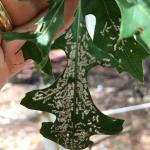
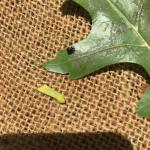 Oak Leafrolling Weevil: Synolabus bipustulatus (synonym Attelabus bipustulatus) is a small, stout, shiny, black weevil with two red spots, one on each elytra (hardened hindwing). (Another oak leaf rolling weevil species exists, Homoeolabus analis, but that insects is primarily orange in color with the exception of a black head and legs.) Weevils of this species (S. bipustulatus) are less than ¼ inch in size. The exact timing of this insect’s life cycle in Massachusetts is not completely understood, but adult weevils were observed by the Massachusetts Department of Agricultural Resources and reported to UMass Extension on 6/10/2021 from Middlesex County, Massachusetts. Adult weevils chew slits on either side of the midrib of the host plant leaf, where they will lay an egg at the tip of the leaf. The leaf is then folded (by the weevil) along the midrib and rolled into a tidy cylinder, kind of like a sleeping bag. By the end of this rolling, the egg is positioned near the center of the roll. Once the egg hatches, the immature weevil larva (which is legless, curved, and plump with a brown head) feeds on the tissue inside the rolled leaf. Once the larva matures, it pupates inside the rolled leaf. Adults emerge again to continue the life cycle and there may be multiple generations per year in certain locations of this insect’s geographic range. Leafrolling weevils have been noted on 16 species of oak and 2 species of chestnut. These insects are rarely considered pests, as they typically do not cause noticeable damage to their host plants. Management is seldom considered necessary.
Oak Leafrolling Weevil: Synolabus bipustulatus (synonym Attelabus bipustulatus) is a small, stout, shiny, black weevil with two red spots, one on each elytra (hardened hindwing). (Another oak leaf rolling weevil species exists, Homoeolabus analis, but that insects is primarily orange in color with the exception of a black head and legs.) Weevils of this species (S. bipustulatus) are less than ¼ inch in size. The exact timing of this insect’s life cycle in Massachusetts is not completely understood, but adult weevils were observed by the Massachusetts Department of Agricultural Resources and reported to UMass Extension on 6/10/2021 from Middlesex County, Massachusetts. Adult weevils chew slits on either side of the midrib of the host plant leaf, where they will lay an egg at the tip of the leaf. The leaf is then folded (by the weevil) along the midrib and rolled into a tidy cylinder, kind of like a sleeping bag. By the end of this rolling, the egg is positioned near the center of the roll. Once the egg hatches, the immature weevil larva (which is legless, curved, and plump with a brown head) feeds on the tissue inside the rolled leaf. Once the larva matures, it pupates inside the rolled leaf. Adults emerge again to continue the life cycle and there may be multiple generations per year in certain locations of this insect’s geographic range. Leafrolling weevils have been noted on 16 species of oak and 2 species of chestnut. These insects are rarely considered pests, as they typically do not cause noticeable damage to their host plants. Management is seldom considered necessary.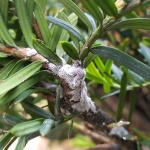 Taxus Mealybug: Dysmicoccus wistariae will produce honeydew and lead to sooty mold growth, yellowing of needles, and sparsely foliated plants. Eventual dieback may be possible. This species is commonly associated with taxus in New England, but can be occasionally found on dogwood, rhododendron, Prunus spp., maple, andromeda, and crabapple. These mealybugs are found on stems and branches and particularly like to congregate at branch crotches. Taxus mealybug feeds in the inner bark tissue of the trunk and branches. Adult females are present from June to August and give birth to living young in the summer. Immatures overwinter. A single generation may occur per year in New England, but areas to the south can have multiple generations of this insect. Management may be targeted between 246-618 GDD’s, base 50°F. Horticultural oil and neem oil may be used.
Taxus Mealybug: Dysmicoccus wistariae will produce honeydew and lead to sooty mold growth, yellowing of needles, and sparsely foliated plants. Eventual dieback may be possible. This species is commonly associated with taxus in New England, but can be occasionally found on dogwood, rhododendron, Prunus spp., maple, andromeda, and crabapple. These mealybugs are found on stems and branches and particularly like to congregate at branch crotches. Taxus mealybug feeds in the inner bark tissue of the trunk and branches. Adult females are present from June to August and give birth to living young in the summer. Immatures overwinter. A single generation may occur per year in New England, but areas to the south can have multiple generations of this insect. Management may be targeted between 246-618 GDD’s, base 50°F. Horticultural oil and neem oil may be used.- Twolined Chestnut Borer: Agrilus bilineatus is a native jewel beetle (also known as a flatheaded borer) in the Family Buprestidae. This insect is also in the same genus as the invasive emerald ash borer. The twolined chestnut borer is native to Massachusetts, much of New England, and the eastern United States. This species has one generation per year and adults are typically active from April – August, depending upon location and temperature. Adults will conduct some maturation feeding on oak prior to mating. Females will lay clusters of tiny eggs in the cracks and crevices of bark. Larvae hatch from the eggs in 1-2 weeks and burrow through the bark into the cambium, where they feed in a similar manner to the emerald ash borer, creating meandering galleries as they feed. (The galleries of the twolined chestnut borer can be straight in very stressed trees.) Larvae typically mature by August – October and burrow to the outer bark where they create a chamber in which they overwinter. Pupation occurs the following spring and adults emerge through D-shaped exit holes that are approximately 1/5 inch wide. In the northern extent of this insect’s range, they can take 2 years to complete their life cycle. Larvae of this insect have been recorded from eastern white oak, common post oak, burr oak, scarlet oak, northern red oak, and eastern black oak. Adults have been recorded on fir and pin oak. These insects are attracted to stressed host plants and typically become a secondary factor in the decline of the tree.
- Two-Spotted Spider Mite: Tetranychus urticae is a “warm-season” mite that loves hot and dry weather, which may favor the quick reproduction and build-up of this pest. Management should seek to preserve beneficial predatory mites. Monitor susceptible hosts (elm, maple, redbud, ash, black locust, tuliptree, and many deciduous shrubs) for increasing numbers of these mites until mid-August. Mites will be found on the undersides of leaves and cause stippling of the foliage.
- Viburnum Leaf Beetle: Pyrrhalta viburni is a beetle in the family Chrysomelidae that is native to Europe, but was found in Massachusetts in 2004. Larvae have completed their feeding and have moved to the soil to pupate and adult beetles will soon emerge to feed on foliage, mate, and lay eggs which will overwinter. This beetle feeds exclusively on many different species of viburnum, which includes, but is not limited to, susceptible plants such as V. dentatum, V. nudum, V. opulus, V. propinquum, and V. rafinesquianum. Some viburnum have been observed to have varying levels of resistance to this insect, including but not limited to V. bodnantense, V. carlesii, V. davidii, V. plicatum, V. rhytidophyllum, V. setigerum, and V. sieboldii. More information about viburnum leaf beetle may be found at http://www.hort.cornell.edu/vlb/ .
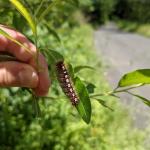

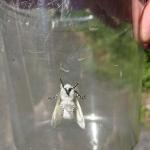
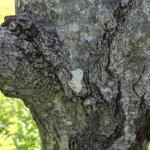
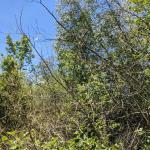
 White Satin Moth: Leucoma salicis was recently reported from Beartown State Forest (Berkshire County) on 6/23/2021 by the Massachusetts Department of Conservation and Recreation, Forest Health Program. This is the same location that caterpillars of this species were seen defoliating their hosts in 2020. Caterpillars, pupae, adult moths, and egg masses were observed at this location on 6/24/2021. Very noticeable predation of the adult moths by birds was also witnessed, along with the aftermath of this predation (remains of white satin moth wings on the ground).
White Satin Moth: Leucoma salicis was recently reported from Beartown State Forest (Berkshire County) on 6/23/2021 by the Massachusetts Department of Conservation and Recreation, Forest Health Program. This is the same location that caterpillars of this species were seen defoliating their hosts in 2020. Caterpillars, pupae, adult moths, and egg masses were observed at this location on 6/24/2021. Very noticeable predation of the adult moths by birds was also witnessed, along with the aftermath of this predation (remains of white satin moth wings on the ground).
The caterpillars of this species have a unique color pattern, which helps us distinguish them from others. The dorsal (back) side of the caterpillar is marked with 10-11 white, intersegmental spots as well as paired, red “setal warts”. The sides of the caterpillars are blueish gray. These caterpillars are known to the edges of waterways, woodlands, and forests from Canada to northwestern Connecticut and central New York. One generation occurs per year with mature caterpillars known in May and June. Host plants include aspen, poplar, and willow and are fed upon by the caterpillars of this species.
The white satin moth was introduced from Europe and first reported between Boston, MA and Hampton, New Hampshire in 1920. This insect is said to overwinter in the third instar (caterpillars pass through seven instars), either individually or in small groups. In the spring time, caterpillars leave their areas of hibernation to feed on nearby leaves. Caterpillars spin a thin cocoon between leaves or between exfoliating or thick bark crevices. Pupae are dark brown/black and often in a thin, loose silken sack. Pupae also sport brightly colored, yellow setae (hairs) that make them quite attractive. Pupation begins by the end of June. Shortly thereafter, moths emerge and females lay egg masses covered in a frothy, white material from July – mid-August. Eggs hatch sometime in August, and larvae will conduct feeding in August and September.
While caterpillars of this species are not noted to be of particular concern with regard to causing allergic reactions such as dermatitis, they are a type of tussock moth and do possess hairs, so they should not be handled/approached with caution particularly by sensitive individuals.
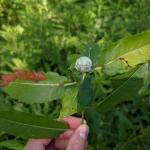 Willow Pinecone Gall Midge: Rhabdophaga strobiloides is in the Family Cecidomyiidae (Gall and Wood Midges) and induces the creation of a splendid and very interesting pinecone shaped gall on willow (Salix spp.). Female midges begin the gall formation when they lay a single egg at the terminal bud of willows in the spring. The female midge injects chemicals into the plant, along with chemicals secreted/exuded by the egg and the larva once the egg hatches, which direct the plant tissues involved to form the shape of a pinecone. Early-season galls are ball-like, such as the one photographed in Berkshire County, MA on 6/24/2021 pictured here. As the growing season progresses, the galls become cone-shaped. The single midge fly larva develops inside the center of the gall. Pupation will occur next spring, with adults emerging from the top of the gall, who will give rise to next year’s population. These insects cause little to no damage to the overall health of their host plants. In fact, multiple entomologists agree that they add ornamental value and interest!
Willow Pinecone Gall Midge: Rhabdophaga strobiloides is in the Family Cecidomyiidae (Gall and Wood Midges) and induces the creation of a splendid and very interesting pinecone shaped gall on willow (Salix spp.). Female midges begin the gall formation when they lay a single egg at the terminal bud of willows in the spring. The female midge injects chemicals into the plant, along with chemicals secreted/exuded by the egg and the larva once the egg hatches, which direct the plant tissues involved to form the shape of a pinecone. Early-season galls are ball-like, such as the one photographed in Berkshire County, MA on 6/24/2021 pictured here. As the growing season progresses, the galls become cone-shaped. The single midge fly larva develops inside the center of the gall. Pupation will occur next spring, with adults emerging from the top of the gall, who will give rise to next year’s population. These insects cause little to no damage to the overall health of their host plants. In fact, multiple entomologists agree that they add ornamental value and interest!
Concerned that you may have found an invasive insect or suspicious damage caused by one? Need to report a pest sighting? If so, please visit the Massachusetts Introduced Pests Outreach Project: http://massnrc.org/pests/pestreports.htm .
Reported by Tawny Simisky, Extension Entomologist, UMass Extension Landscape, Nursery, & Urban Forestry Program
Additional Resources
Pesticide License Exams - The MA Dept. of Agricultural Resources (MDAR) is now holding exams online. For more information and how to register, go to: https://www.mass.gov/pesticide-examination-and-licensing.
To receive immediate notification when the next Landscape Message update is posted, join our e-mail list or follow us on Facebook.
For a complete listing of upcoming events, see our upcoming educational events https://ag.umass.edu/landscape/upcoming-events
For commercial growers of greenhouse crops and flowers - Check out UMass Extension's Greenhouse Update website
For professional turf managers - Check out Turf Management Updates
For home gardeners and garden retailers - Check out our home lawn and garden resources.
Diagnostic Services
UMass Laboratory Diagnoses Landscape and Turf Problems - The UMass Extension Plant Diagnostic Lab is available to serve commercial landscape contractors, turf managers, arborists, nurseries and other green industry professionals. It provides woody plant and turf disease analysis, woody plant and turf insect identification, turfgrass identification, weed identification, and offers a report of pest management strategies that are research based, economically sound and environmentally appropriate for the situation. Accurate diagnosis for a turf or landscape problem can often eliminate or reduce the need for pesticide use. For sampling procedures, detailed submission instructions and a list of fees, see Plant Diagnostic Laboratory
Soil and Plant Nutrient Testing - The University of Massachusetts Soil and Plant Nutrient Testing Laboratory is located on the campus of The University of Massachusetts at Amherst. Testing services are available to all. The lab provides test results and recommendations that lead to the wise and economical use of soils and soil amendments. For more information, visit the UMass Soil and Plant Nutrient Testing Laboratory web site. Routine soil analysis and particle size analysis ONLY (no other types of soil analyses available at this time). Turnaround time: Please plan for the fact that date of receipt in the lab is affected by weekends, holidays, shipping time, and time for UMass Campus Mail to deliver samples to the lab. Campus Mail delivery only takes place on Monday, Wednesday, and Friday due to pandemic restrictions.
Tick Testing - The UMass Center for Agriculture, Food, and the Environment provides a list of potential tick identification and testing options at: https://ag.umass.edu/resources/tick-testing-resources.



